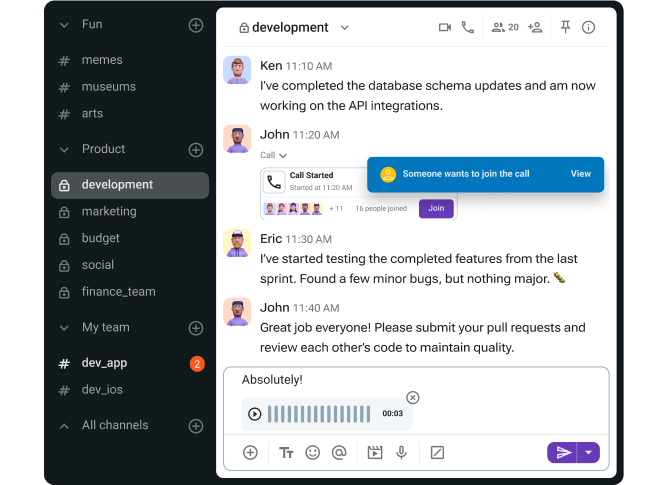Les situations de communication sont tous types de situation dans laquelle la communication existe.
Dans un environnement professionnel, vous participerez probablement à divers types de situations de communication en travaillant avec vos collègues et supérieurs.
Certaines de ces situations de communication peuvent être formelles, structurées et planifiées à l'avance, tandis que d'autres peuvent être informelles, spontanées, ou même une combinaison de tous ces facteurs.
Dans ce guide, nous couvrirons les types de situations de communication dans lesquelles vous pourriez vous trouver en opérant dans un environnement commercial, tels que :
- Divers types de conversations,
- Le feedback,
- Réunions,
- Discours en public,
- Négociations
- Entretiens d'embauche, et
- Conflits.
Nous allons vous illustrer également chacune de ces occasions avec un exemple de situation de communication approprié et offrirons des conseils utiles sur la façon de gérer différentes circonstances.

Conversations
Selon la définition du dictionnaire Cambridge, les conversations impliquent la communication entre deux ou plusieurs individus, durant laquelle « des pensées, des sentiments et des idées sont exprimés, des questions sont posées et répondues, ou des nouvelles et des informations sont échangées ».

Les conversations peuvent inclure et combiner divers types de communication:
- La communication écrite,
- La communication verbale,
- La communication non verbale, et
- La communication visuelle.
Les conversations peuvent être planifiées ou imprévues, et elles peuvent avoir lieu entre collègues, ou entre employés et leurs supérieurs.
Maintenant, entrons dans les détails de chacun de ces types de conversation et voyons comment ils se manifestent en pratique.
Conversations planifiées
Les conversations planifiées sont des discussions dans lesquelles le sujet abordé a fait l'objet d'une réflexion préalable.
De telles conversations peuvent avoir lieu entre deux individus, auquel cas nous les appelons des conversations individuelles (1:1). Ou, elles peuvent avoir lieu entre plus de deux individus, auquel cas elles peuvent être appelées des discussions de groupe.
Lorsque la conversation semble être plus difficile, vous pouvez prendre certaines précautions pour vous aider à vous sentir plus préparé et plus en contrôle. Par exemple, vous pouvez réfléchir à :
- Ce que vous voulez dire,
- Comment les autres personnes peuvent réagir,
- Comment la conversation peut se dérouler, et
- Comment la conversation peut se terminer.
Si la conversation est planifiée à l'avance par toutes les parties, avec un ordre du jour, une date, une heure et un lieu clairs, on parle généralement de réunion.
Exemple : Une spécialiste en vente d'entreprise veut montrer à son supérieur à quel point elle travaille et à quel point elle a contribué aux objectifs de l'entreprise, alors elle lui envoie un message formel sur Pumble concernant le travail qu'elle a accompli au cours de la période précédente. En réponse, elle reçoit une félicitation pour son dévouement et son travail acharné.
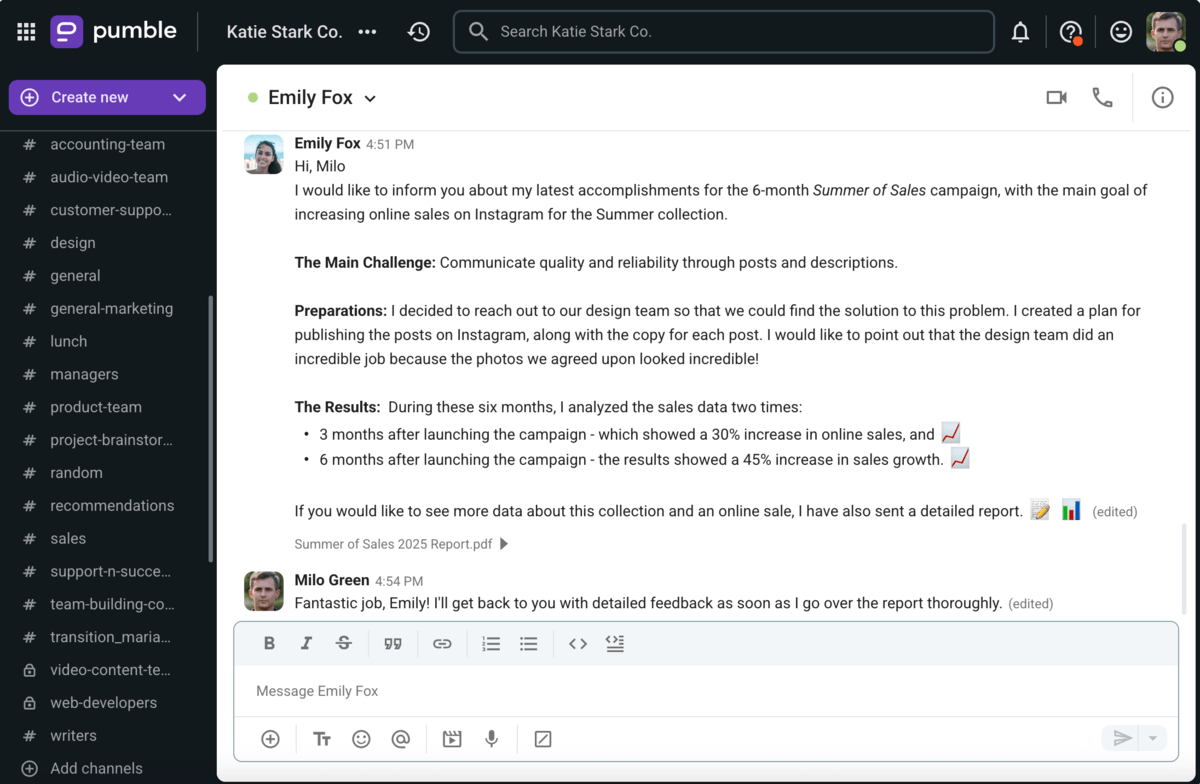
Conseils pour améliorer conversations planifiées
Pour qu'une conversation planifiée se déroule bien, vous devez être préparé. Heureusement, comme ces types de conversations sont planifiées à l'avance, vous avez le temps de vous préparer.
Voici quelques conseils pour de meilleures conversations planifiées :
- Créez un ordre du jour ou demandez. Que doit être discuté et dans quel ordre ? Prenez des notes pour vous aider à maintenir la conversation en bonne voie si l'interaction est verbale. Si le sujet de discussion est entre les mains d'autres personnes, demandez-leur l'ordre du jour à l'avance et préparez-vous.
- Structurez votre communication. Structurez votre interaction de manière à ce qu'elle soit facile à suivre. Si vous interagissez via une plateforme de communication écrite, divisez le message en sections et paragraphes, ou rédigez un message cohérent si vous utilisez une application de communication d'équipe comme Pumble.
- Pensez à ce qui pourrait vous être demandé. Une conversation est une voie à double sens, et vous ne pouvez vous préparer que dans une certaine mesure. Cependant, vous pouvez essayer de penser aux questions potentielles et les points de blocage et vous y préparer.
Avoir les conversations structurées sur Pumble
Conversations imprévues
Les conversations imprévues sont celles qui se produisent sur un coup.
De telles conversations peuvent également avoir lieu entre deux individus (conversations en tête-à-tête ou 1:1), ou entre plus de deux individus (discussions de groupe).
Elles peuvent commencer comme des discussions informelles et se transformer en conversations formelles, mais elles peuvent aussi commencer formellement et mener à des sujets plus informels par la suite.
Dans les cas où la conversation imprévue est difficile, elle est généralement déclenchée par des émotions fortes et peut laisser les communicateurs avec de fortes émotions.
Exemple : Un développeur web contacte son collègue pour lui demander ce qu'il mange pour le déjeuner. Pendant qu'ils en discutent, la conversation se tourne rapidement vers une discussion semi-formelle sur les solutions de conception des pages de destination du site web de leur nouveau client.
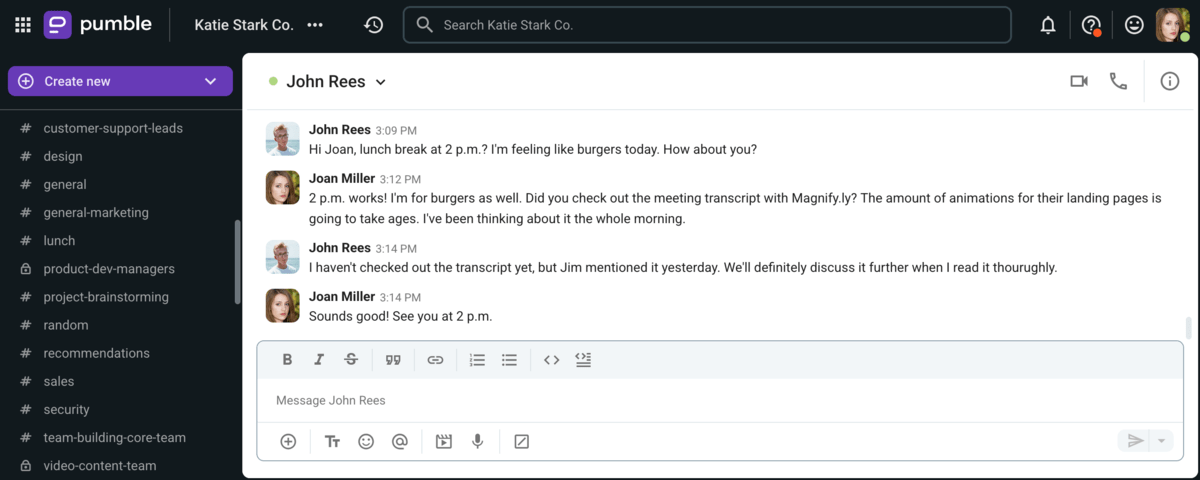
Gérer tous types de conversations avec Pumble
Conseils pour améliorer les conversations imprévues
Les conversations imprévues peuvent nous prendre au dépourvu, mais elles n'ont pas à être difficiles à gérer. Voici quelques conseils pour vous aider à avoir de meilleures conversations imprévues au travail :
- Écoutez attentivement. Il est facile de mal comprendre si vous ne savez pas quel type de conversation vous attend, vous devez donc écouter attentivement pour bien saisir le message.
- Réfléchissez avant de parler. Même si l'interaction est impromptue, assurez-vous que ce que vous dites est en accord avec ce que vous voulez transmettre. Sinon, vous pourriez finir par dire quelque chose d'inapproprié ou blesser involontairement l'autre personne.
- Clarifie. Si vous n'êtes pas sûr d'avoir compris quelque chose ou si vous soupçonnez que l'interlocuteur a peut-être mal compris, prenez un moment pour clarifier ou demander. Cela vous évitera des tensions ou des conflits inutiles.
- Faites un suivi. Les conversations imprévues sont généralement très peu structurées, donc si l'interaction a pris une tournure plus formelle, par exemple, vous avez fini par discuter d'un plan pour un nouveau projet lors d'une discussion à la fontaine à eau, assurez-vous de faire un suivi avec un résumé plus formel et structuré.
Conversations entre collègues
Les conversations avec des collègues impliquent des conversations entre deux ou plusieurs employés qui sont au même niveau hiérarchique dans la structure de l'organisation.
Le sujet et le contexte de la conversation peuvent être formels ou informels, selon la situation.
Exemple : Un développeur de logiciels front-end envoie un message direct à un développeur de logiciels back-end assis à côté d'elle, avec une application de communication d'employés : « Tu as une minute ? ». Il veut l'interroger sur un morceau de code spécifique.
Bien que le développeur de logiciels back-end en question ait ses écouteurs et semble entièrement concentré sur sa tâche, il retire ses écouteurs et s'engage dans une conversation rapide avec elle.
C'est un cas où une conversation écrite mène à une conversation verbale en face à face.
Conseils pour améliorer les conversations avec les collègues
Avoir des conversations avec des collègues peut être délicat pour les nouveaux venus, mais si vous restez amical et honnête avec eux, vous serez probablement accueilli avec la même cordialité. Voici quelques conseils généraux pour de meilleures conversations avec des collègues :
- Choisissez le bon canal de communication. Si vous avez besoin d'aide rapide, il est préférable d'approcher un collègue en personne plutôt que d'envoyer un email formel. D'un autre côté, si vous planifiez un cadeau pour un collègue, vous pourriez créer un canal Pumble privé où l'équipe peut discuter du cadeau en privé sans avoir l'air suspect en chuchotant autour.
- Soyez accessible. Les gens aimeront vous parler si vous êtes accessible, c'est-à-dire que vous souriez, hochez la tête, engagez de petites conversations, écoutez activement, encouragez les retours, etc.
- Soyez prévenant envers vos collègues. Respectez le temps et l'énergie de vos collègues et ne les dérangez pas inutilement. N'encombrez pas la vue principale d'un canal de communication — démarrez un fil de discussion à partir du message où vous pouvez discuter du problème sans déranger les autres avec des notifications.
Explorer les canaux sur Pumble
Conversations entre employés et supérieurs
Les conversations entre employés et leurs supérieurs, tels que les managers, sont des conversations entre deux ou plusieurs professionnels qui ne sont pas au même niveau hiérarchique dans la structure de l'organisation.
Le sujet de la conversation peut aussi être formel ou informel, selon la situation. Cependant, considérant qu'ils n'appartiennent pas au même niveau hiérarchique, le sujet et le contexte de la conversation sont plus susceptibles d'être formels.
Exemple : Un chef d'équipe du service RH envoie un message dans un canal public d'une application de communication d'équipe, pour discuter de la prochaine évaluation de performance avec les employés.
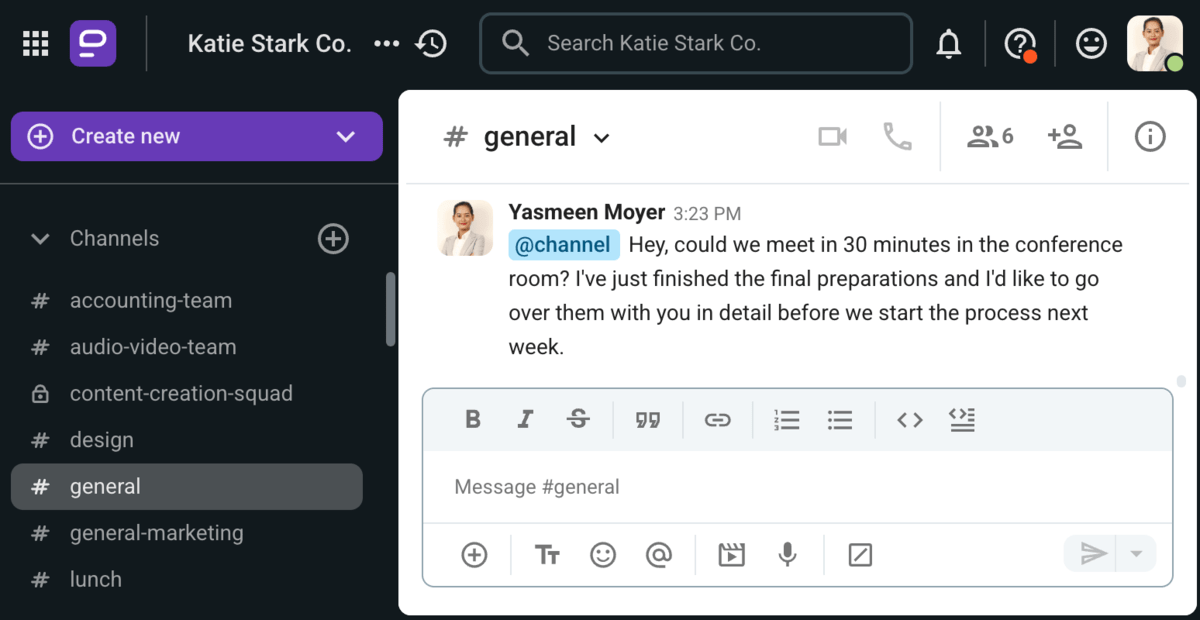
Renforcer votre équipe avec Pumble
L'équipe arrive sous peu, et ils s'engagent dans une discussion rapide.
C'est un autre cas où une conversation écrite mène à une conversation verbale en face-à-face.
Conseils pour améliorer les conversations avec les supérieurs
Beaucoup de gens luttent pour parler à leurs supérieurs, surtout quand ils ont besoin d'aborder un sujet sensible, tel qu'une augmentation. Voici donc quelques conseils pour vous aider à avoir une meilleure conversation avec un supérieur :
- Soyez direct. Votre manager ou un autre supérieur est probablement très occupé, alors soyez clair et concis.
- Soyez honnête. Si un supérieur veut connaître votre opinion, il le pense. N'hésitez pas à partager votre opinion honnête, surtout si cela vous concerne directement.
- Soyez professionnel. Être honnête sans tact peut sembler impoli. Peu importent vos sentiments sur le sujet, gardez vos émotions à distance et transmettez le message sur un ton calme et professionnel.
Conseils pour améliorer conversations avec les employés
Être de l'autre côté de la conversation employé/supérieur peut être tout aussi stressant. Voici quelques conseils pour vous aider :
- Soyez respectueux. Soyez prévenant envers vos subordonnés et essayez de les mettre à l'aise en leur montrant du respect, en les écoutant vraiment et en les traitant comme des égaux dans la conversation.
- Vérifiez votre ton. Ne parlez jamais de haut à vos employés. S'ils proposent une idée et que vous ne l'aimez pas, louez leur initiative, remerciez-les et expliquez pourquoi cela ne fonctionnerait pas au lieu de les rejeter.
- Ayez une politique de porte ouverte. Avoir une politique de porte ouverte signifie que les employés sont libres de vous aborder avec n'importe quel problème sans crainte ni hésitation. Cela encourage la communication ouverte et une véritable relation de confiance.
🎓 Astuce Pro de Pumble
Pour en savoir plus sur les différents types de conversations en milieu de travail, des bavardages aux discussions formelles, consultez nos blogs :
Feedback
Selon le dictionnaire Merriam-Webster, le feedback est « la transmission d'informations évaluatives ou correctives concernant une action, un événement ou un processus à la source originale ou de contrôle ».

En termes de structure, le feedback peut se présenter comme un feedback non structuré — imprévu en termes de timing et de contenu, fournissant des éloges ou des réprimandes rapides. Le feedback structuré, d'autre part, est systématique en termes de communication, avec un plan clair pour le timing et le contenu, comme les évaluations de performance.
En termes de constructivité, le feedback peut être :
- Feedback positif — commentaires affirmatifs sur des comportements passés qui devraient être poursuivis,
- Feedback négatif — commentaires correctifs sur des comportements passés qui ne devraient pas être répétés,
- Feedforward positif — commentaires affirmatifs sur des comportements qui devraient améliorer la performance à l'avenir,
- Feedforward négatif — commentaires correctifs sur des comportements qui devraient être évités à l'avenir.
Le feedback peut survenir spontanément, dans ce cas il est généralement informel, ou de manière régulière, auquel cas il est généralement formel.
Les sources de feedback dans un cadre professionnel peuvent inclure :
- Clients — Ils évaluent la qualité des produits et services fournis, via des enquêtes ou un système de plaintes.
- Données statistiques — Elles incluent des mesures statistiques telles que les indicateurs clés de performance (ICP) qui fournissent des informations objectives sur la performance des individus.
- Supérieurs — Ils incluent les superviseurs, les chefs d'équipe et les managers qui peuvent offrir un feedback de performance comparant la performance de l'individu aux flux de travail, procédures et politiques attendus.
- Pairs — Ils incluent les collègues qui occupent des postes identiques ou similaires, et peuvent ainsi fournir un feedback de performance du point de vue d'une personne qui effectue les mêmes types de tâches et de devoirs ou des types similaires.
- Subordonnés — Ils incluent les employés qui offrent un feedback ascendant à leurs supérieurs, tel que des commentaires sur les styles de leadership de leurs managers.
Les types dominants de communication utilisés pour le feedback sont la communication verbale (couplée à une écoute active pour le meilleur effet) et la communication écrite (parfois couplée à des éléments visuels).
Selon Douglas Stone et Sheila Heen, les auteurs de Merci pour le feedback: L'art et la science bien accueillir les retours, il existe 3 types distincts de feedback en milieu de travail :
- Évaluation
- Appréciation, et
- Feedback de coaching.
Voici ce que chacun d'eux représente.
Feedback d'évaluation
Le but du retour d'évaluation est d'aider la personne qui le reçoit à comprendre comment elle a performé dans une tâche, afin de mieux comprendre ce qui est attendu d'elle au travail.
Le feedback d'évaluation peut impliquer :
- Un système de notation ou de classement qui compare les employés les uns aux autres,
- Un ensemble de normes qui compare les employés auxdites normes,
- À la fois un système de notation ou de classement et un ensemble de normes.
Un feedback d'évaluation réussi devrait impliquer :
- La ponctualité,
- Des attentes claires en termes de rôles et de responsabilités pour lesquels l'employé sera évalué,
- Un but clair, en termes de ce sur quoi le feedback se concentrera,
- La responsabilité pour les processus et les résultats,
- Des registres clairs des progrès de l'employé.
Exemple : Un directeur des ventes rédige un rapport de retour d'évaluation, détaillant des éloges et des conseils d'amélioration pour une spécialiste des ventes en entreprise, en termes de son innovation et de sa créativité, de sa collaboration et de son travail d'équipe, de son service client, de sa résolution de problèmes et de ses compétences en communication en général.
Il lui envoie le lien vers le document via un message direct sur Pumble, une application de messagerie professionnelle.

Envoyez et demandez un feedback avec Pumble
Conseils pour améliorer le feedback d'évaluation
Selon les Statistiques sur l'engagement des employés de Pumble, une écrasante majorité d'employés qui reçoivent un feedback hebdomadaire se sentent engagés — jusqu'à 80%.
Voici quelques conseils sur la façon de fournir un meilleur feedback d'évaluation :
- N'utilisez pas de déclarations subjectives et de généralisations. La déclaration « Je sens que vous ne faites pas de votre mieux » est un excellent exemple de ce qu'il ne faut pas dire lors d'un feedback. Au lieu de recourir à des commentaires vagues, signalez les problèmes exacts de performance et comment les résoudre.
- Soyez systématique. Il est préférable d'avoir un format clair et détaillé de ce à quoi un feedback d'évaluation standard devrait ressembler et de s'y tenir. Une évaluation écrite est bien meilleure qu'une discussion informelle et évasive qui laissera le destinataire du feedback confus.
- Soyez honnête. Retenir des informations ne vous aidera ni l'un ni l'autre. Soyez donc direct, mais au lieu de vous fixer sur le problème, concentrez-vous sur la solution.
Feedback d'appréciation
Le but du feedback d'appréciation est de montrer de la reconnaissance ou de remercier un employé pour sa performance et ses contributions.
Un tel feedback est une excellente tactique pour renforcer la confiance et encourager l'employé recevant le feedback à maintenir son bon travail, car ses efforts seront probablement reconnus et appréciés à l'avenir également.
Exemple : Le chef d'équipe d'une équipe produit félicite une chef d'équipe de conception web et son équipe pour la refonte complète de leur site web — les félicitant pour l'innovation, la convivialité et l'aspect pratique. Il associe également la refonte réussie à la croissance récente des ventes du produit en question.
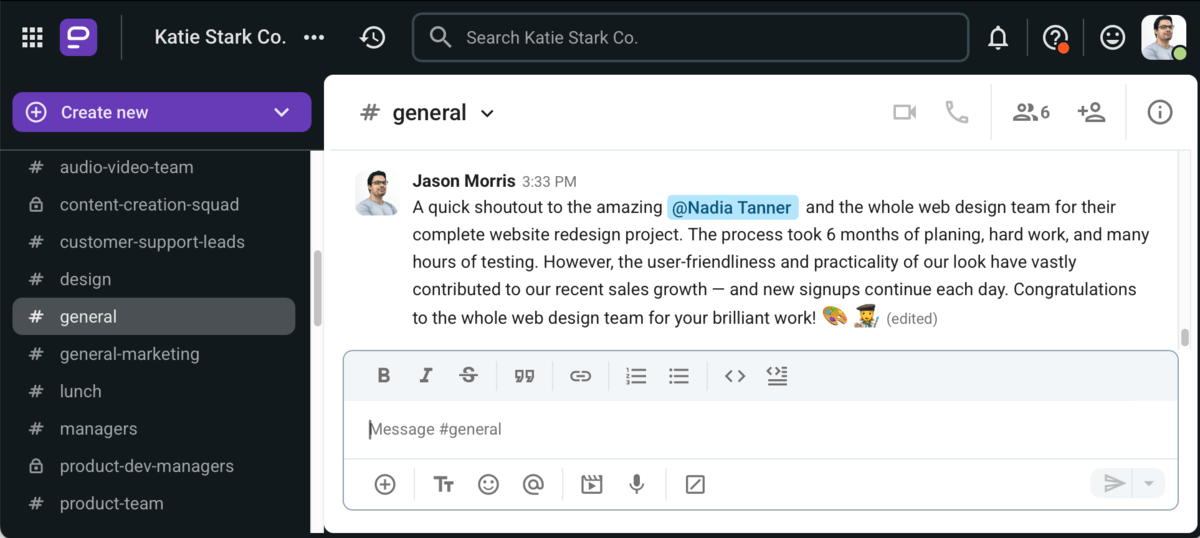
Partager facilement le feedback avec Pumble
Conseils pour donner un meilleur feedback d'appréciation
Pour que le feedback d'appréciation soit réussi, il est préférable que vous :
- Le rendiez spécifique — afin que la personne comprenne ce qu'elle a fait pour mériter des éloges, et ce qu'elle doit continuer à faire.
- Le liiez à une valeur spécifique — afin que la personne puisse mieux comprendre ses rôles et responsabilités au sein d'une entreprise, ainsi que son importance et son niveau de contributions aux objectifs communs.
- Le rendiez authentique — afin que la personne comprenne que le feedback est authentique et sincère, et non une simple courtoisie ou une partie d'une routine.
Feedback de coaching
Le feedback de coaching est une approche collaborative dans laquelle le supérieur d'un employé donne plus de direction à l'employé par le biais de feedback. Ce feedback sert de guide pour le développement de carrière futur de l'employé.
Le but du feedback de coaching est de fournir à la personne qui reçoit le feedback des revues régulières et annuelles qui l'inspireront à viser une croissance et une amélioration continues. Un tel feedback peut contenir des éléments de feedback d'évaluation et d'appréciation.
Exemple : Un directeur du support client donne aux membres de son équipe un feedback de coaching chaque mois. Il organise des réunions individuelles (1:1) à cette fin et fournit un feedback à chaque spécialiste du support client en personne.
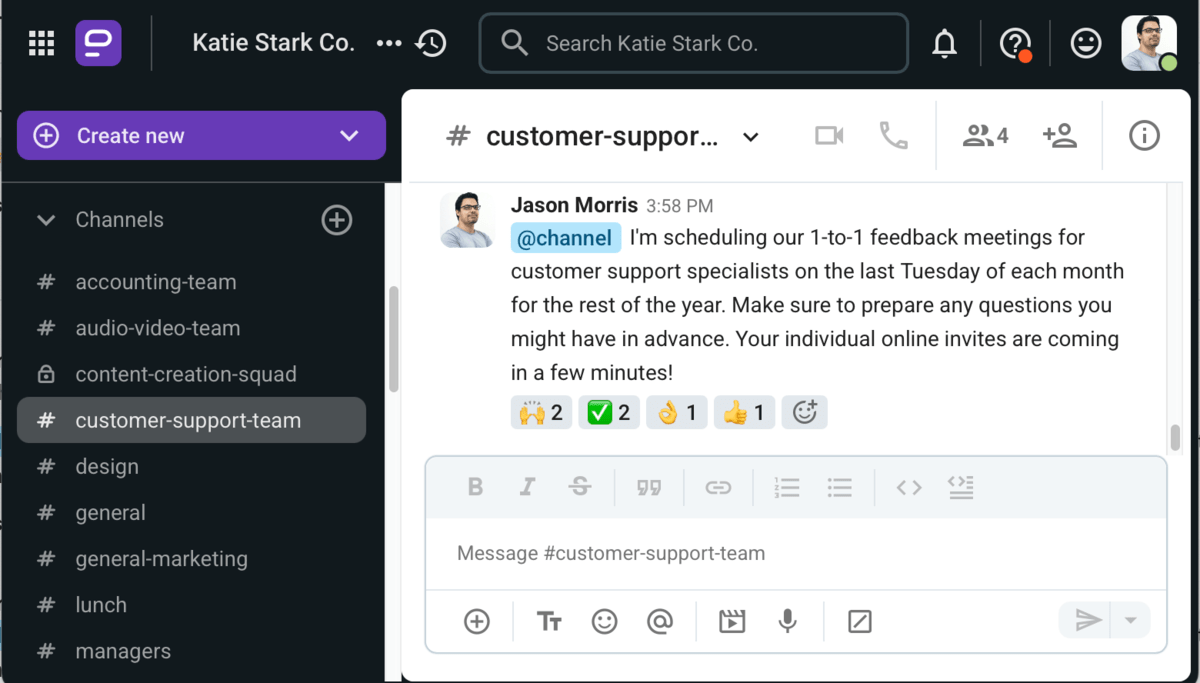
Organiser facilement les sessions de feedback avec Pumble
Conseils pour un meilleur feedback de coaching
Donner un feedback de coaching est une question de cohérence et de recherche constante d'opportunités d'amélioration. Voici quelques conseils sur la façon de réussir le feedback de coaching :
- Équilibrez la critique et l'appréciation. Un feedback régulier doit se concentrer à la fois sur le bon et le mauvais pour maintenir les employés motivés et engagés.
- Adoptez un format standard. Tout comme l'évaluation, le feedback de coaching doit se présenter sous un format familier. Cette familiarité récurrente le rend beaucoup moins intimidant.
- Offre des conseils exploitables. Le feedback de coaching doit viser à trouver des solutions pratiques à des problèmes concrets. Vous pouvez également envisager le « feedforward », une alternative au feedback, caractérisé par la fourniture de commentaires pour l'amélioration d'une action ou d'un comportement en cours plutôt que par la seule critique.
🎓 Astuce Pro de Pumble
Pour une idée plus détaillé de la façon de donner un feedback fantastique et de demander un feedback à vos supérieurs, consultez notre section blog :
Réunions
Selon la définition, les réunions sont un rassemblement plus formel de deux personnes ou plus qui ont pour but de discuter d'un sujet particulier, de partager des informations particulières ou de parvenir à un accord.

Les réunions peuvent avoir lieu en personne ou être menées par téléphone ou un outil de vidéoconférence tel que Pumble.
Les types de communication qui prévalent lors des réunions sont :
- La communication verbale — le type dominant dans un tel scénario de communication,
- La communication non verbale — qui peut accompagner la communication verbale en quantité significative,
- La communication visuelle — qui peut entrer en jeu s'il y a un tableau blanc dans la salle de conférence où les réunions ont lieu, auquel cas elle peut être utilisée pour des cartes mentales, des boucles et d'autres visualisations d'idées, et
- L'écoute active — qui est particulièrement vitale lors des réunions, étant donné que la communication verbale est le type dominant.
En revanche, la communication écrite est plus rare. Mais elle peut entrer en jeu si la réunion régulière ne peut pas avoir lieu — par exemple, la personne qui dirige habituellement les réunions quotidiennes de « stand-up » est actuellement indisponible, elle demande donc aux participants attendus d'écrire sur quoi ils travaillent aujourd'hui dans un fil de discussion d'une application de communication interne..
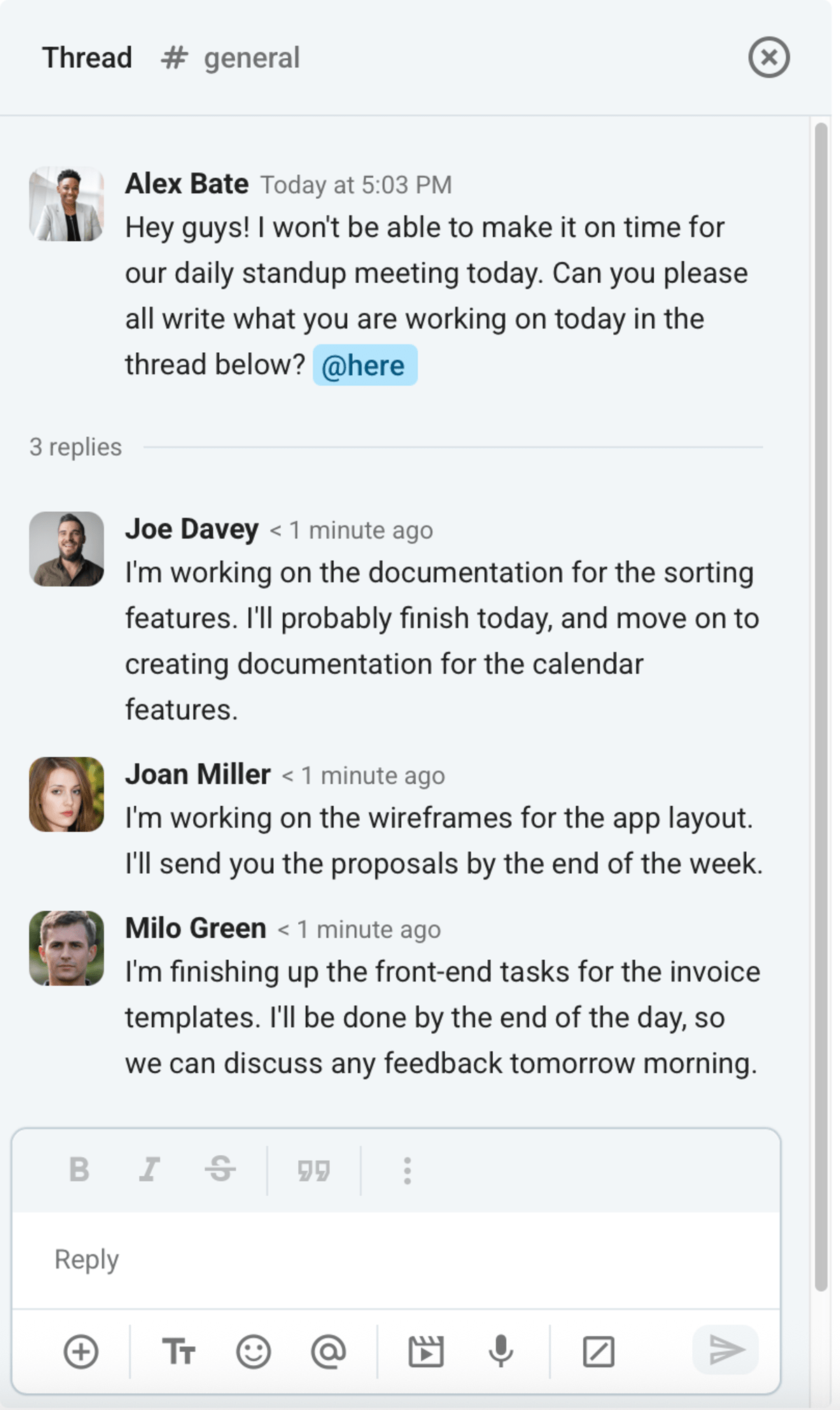
Suivez les conversations avec les fils de discussion de Pumble
Les types de réunions les plus courants sont :
- Les réunions de démarrage,
- Les réunions de mise à jour du statut,
- Les réunions de prise de décision,
- Les réunions de résolution de problèmes,
- Les réunions d'innovation,
- Les réunions de team building, et
- Les réunions d'intégration.
Voici de quoi il s'agit pour chacun des types de réunions listés.
Réunions de démarrage
Une réunion de démarrage est la première rencontre entre l'équipe travaillant sur un projet et le client qui a commandé le projet.
De telles réunions incluent généralement :
- Les présentations entre les membres de l'équipe et le client,
- La discussion des rôles que les membres de l'équipe auront dans ce projet,
- Des explications de processus supplémentaires, s'il y a de nouveaux membres de l'équipe qui ne sont pas familiers avec les normes de qualité de l'entreprise,
- Toutes les formalités légales nécessaires, comme l'équipement supplémentaire requis,
- Diverses autres activités de planification de projet.
Exemple : Une équipe composée d'un développeur logiciel front-end, d'un développeur logiciel back-end et d'un designer, ayant leur première réunion avec un client qui a engagé leur entreprise pour construire un site web de voyage.
Conseils pour une réunion de démarrage efficace
Une réunion de démarrage est la réunion la plus importante que vous aurez avec un client, qui donnera le ton pour la collaboration future sur le projet. Voici comment la rendre réussie :
- Ayez un ordre du jour et respectez-le. Préparez un ordre du jour et présentez les principaux points de discussion avant de commencer réellement. Cela vous permettra de respecter les délais et de rester sur le sujet.
- Ne émettez pas d'informations. L'objectif de ce type de réunion est de trouver un terrain d'entente et de discuter du projet dans son ensemble. Vous pouvez laisser les détails pour votre réunion d'équipe interne.
- Établissez le canal et la fréquence de communication. Comment communiquerez-vous sur l'avancement du projet ? Devriez-vous avoir des points de contrôle hebdomadaires ? Comment pouvez-vous vous joindre entre les réunions si quelque chose survient ? Établir les termes de communication dès le départ vous évitera bien des problèmes plus tard.
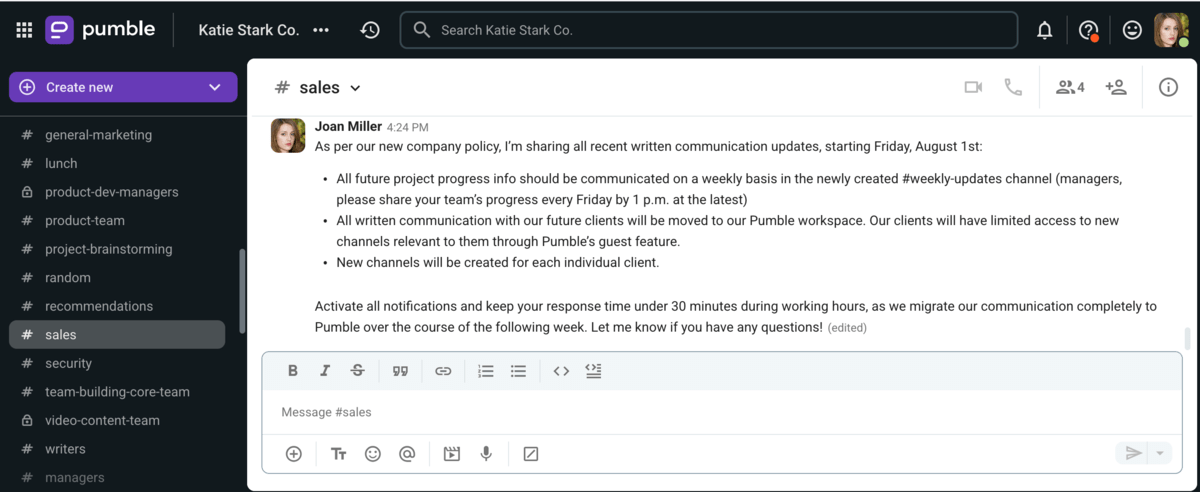
Coopérer avec des clients grâce à la fonctionnalité Accès invité de Pumble.
Réunions de mise à jour du statut
Les réunions de mise à jour du statut impliquent des rencontres régulières entre les membres de l'équipe, dans le but de partager des mises à jour sur les progrès individuels, les défis et les plans de travail futurs.
De telles réunions de mise à jour du statut sont généralement programmées régulièrement, par exemple tous les jours à une heure particulière, ou toutes les semaines, à un jour et une heure particuliers.
Exemple : Une série de réunions de « stand-up » (réunions quotidiennes), tous les jours à 10 heures du matin, qui incluent les membres de l'équipe de développement chargée de développer et de maintenir une application de mode.
Conseils pour une réunion de mise à jour du statut réussie
Les réunions de mise à jour du statut étant une occurrence régulière, elles doivent être très efficaces et productives. Voici comment tirer le meilleur parti de vos réunions de mise à jour du statut :
- Envisagez de partager les informations sur les progrès à l'avance. Selon la taille de l'équipe, vous pourriez envisager de partager vos mises à jour de statut sous forme écrite avant la réunion. De cette façon, vous pourrez tous venir préparés à discuter des difficultés et à partager des idées.
- Ne laissez pas un sujet étroit accaparer la réunion. S'il y a un sujet particulier qui préoccupe particulièrement quelques membres de l'équipe, il est préférable de le reporter à une autre réunion, séparée, ou d'en discuter d'une autre manière.
- Assurez-vous que chaque voix est entendue. Le but de cette réunion est d'obtenir une mise à jour du statut de chaque membre de l'équipe, alors assurez-vous que chacun apporte au moins une contribution et ne laissez pas quelques personnes « détourner » la réunion.
Organiser des réunions quotidiennes de mise à jour sur Pumble
Réunions de prise de décision
Les réunions de prise de décision impliquent des rassemblements dédiés de groupes de personnes plus petits ou plus grands, dans le but de prendre des décisions importantes.
De telles réunions peuvent impliquer :
- Collecte d'informations,
- L'évaluation des options disponibles,
- La comparaison des options disponibles entre elles, et
- Le vote sur les solutions les plus appropriées et similaires.
Exemple : Une équipe RH tenant une réunion pour décider du meilleur candidat pour un spécialiste du support client à qui elle souhaite faire une offre d'emploi, en se basant sur les résultats des entretiens.
Conseils pour des réunions de prise de décision réussies
Les réunions de prise de décision permettent à chaque membre de l'équipe de contribuer à trouver la meilleure façon d'atteindre l'objectif commun. Voici comment les rendre efficaces :
- Établissez les critères de prise de décision. Il est utile d'avoir une formule claire pour comparer les options entre elles.
- Parlez de l'expertise de chaque membre de l'équipe. Chaque membre de l'équipe a son propre rôle dans le projet, alors consultez chacun d'eux sur leur domaine d'expertise.
- Ne laissez pas la réunion dévier de son cours. Gardez la discussion ciblée. Si quelqu'un a une idée sur autre chose, encouragez-le à l'écrire et à la garder pour une autre réunion.
Réunions de résolution de problèmes
Les réunions de résolution de problèmes impliquent des rassemblements dédiés de groupes de personnes plus petits ou plus grands, dans le but de traiter un problème précédemment identifié ou de créer des stratégies et des plans pour l'avenir.
De telles réunions exigent généralement que les participants :
- Définissent la portée des problèmes,
- Identifient les priorités des problèmes,
- Identifient les opportunités de résolution de problèmes,
- Identifient les menaces potentielles,
- Réfléchissent et évaluent les solutions potentielles, ou
- Votent sur les solutions les plus appropriées.
Exemple : Une équipe de développement web participant à une réunion vidéo impromptue pour corriger des problèmes mineurs qui pourraient améliorer les performances du site web.
Conseils pour une réunion de résolution de problèmes efficace
Ces réunions ont un objectif très spécifique, à savoir résoudre le problème, ce qui ne laisse pas beaucoup de marge de manœuvre. Voici comment organiser une réunion de résolution de problèmes réussie :
- Encouragez les gens à trouver les failles de chaque idée. La puissance des réunions de résolution de problèmes réside dans les différentes perspectives. Si une personne ne voit pas de problème dans une solution proposée, quelqu'un d'autre est susceptible de le découvrir.
- Désignez une personne pour prendre des notes. Les membres de l'équipe peuvent rapidement échanger des idées, et quelqu'un devrait les noter par écrit pour référence future.
- Faites un suivi par écrit. Dans l'exemple de l'équipe de développement web ci-dessus, quelqu'un utiliserait les notes pour rédiger une version écrite de la décision finale et l'épingler dans l'application de communication professionnelle de leur équipe choisie afin que tout le monde puisse s'y référer au besoin.
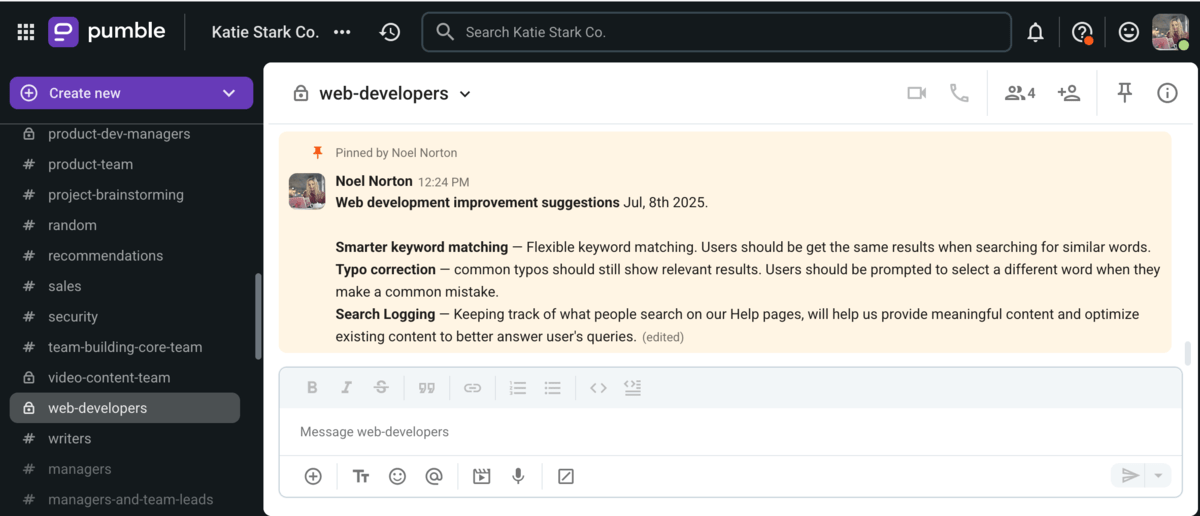
Résoudre les problèmes rapidement avec Pumble
Réunions d'innovation
Les réunions d'innovation impliquent le processus de brainstorming avec votre équipe, dans le but de partager des idées et de trouver des solutions innovantes en sortant des sentiers battus.
Les participants à une telle réunion peuvent utiliser diverses techniques pour trouver autant d'idées appropriées que possible, avant de dresser une liste restreinte des meilleures options disponibles qu'ils peuvent examiner plus en détail.
Ces techniques peuvent inclure :
- Une longue session de brainstorming,
- Le classement et l'évaluation des idées, basés sur des critères spécifiques et des arguments clairs, ou
- Le vote sur les meilleures idées.
Exemple : Une équipe marketing participant à une réunion pour trouver un nom approprié pour la nouvelle application de conversion de temps de l'entreprise.
Conseils pour améliorer réunions d'innovation
Les réunions d'innovation sont un excellent moment pour que l'équipe laisse libre cours à sa créativité. Voici comment en tirer le meilleur parti :
- Définissez le cadre. Bien que ces types de réunions permettent aux participants de laisser libre cours à leur imagination, il doit y avoir un cadre pour aider à focaliser l'attention de tous, ou les idées peuvent partir dans tous les sens. Par exemple, vous pouvez vous concentrer sur l'innovation dans un département ou un aspect de votre entreprise.
- Ayez un facilitateur. Demandez à quelqu'un de diriger la réunion et de guider les participants. Cela aidera à maintenir un ton respectueux et permettra à chacun de contribuer sans se chevaucher.
- Terminez par des actions concrètes. Si possible, incitez les participants à assumer la responsabilité de leurs idées en s'engageant à prendre des mesures spécifiques vers l'exécution de l'idée.
Organiser les sessions de brainstorming avec Pumble
Réunions de team building
Les réunions de team building impliquent des réunions dédiées au renforcement des relations professionnelles entre les membres d'une équipe et la culture d'entreprise dans son ensemble.
L'objectif de ces réunions peut tourner autour de la planification et de la réalisation de sorties, d'événements ou d'activités de bureau amusantes de cohésion d'équipe.
Exemple : Une réunion axée sur la réalisation d'une série de jeux et d'activités de gestion du temps rapides mais amusants, tels que « Le mystère à une syllabe », « Yin et Yang » et « Design à l'aveugle ».
Conseils pour améliorer les réunions de team building
Les réunions de team building d'équipe sont un excellent moyen de renforcer l'équipe. Voici quelques conseils pour les réussir :
- Dirigez avec intention. Bien sûr, les réunions de team building visent à socialiser avec les collègues, mais qu'attendez-vous d'autre d'elles ? Peut-être souhaitez-vous intégrer certains aspects de la culture d'entreprise, comme l'établissement de la confiance. Cette intention vous aidera à développer de meilleures activités de team building.
- Envisagez de les programmer pendant les heures de travail. Votre équipe appréciera beaucoup plus la réunion si elle offre une petite pause dans le travail. Elle n'a pas non plus besoin d'être trop longue.
- Choisissez des activités qui favorisent la collaboration. Apprendre à travailler ensemble dans une atmosphère détendue aidera également votre équipe à améliorer sa collaboration au bureau.
Établissez des relations avec vos collègues — utilisez Pumble
Réunions d'intégration
Les réunions d'intégration impliquent généralement une série d'événements qui aident le nouvel employé à comprendre :
- Ce qui est attendu de lui à son nouveau emploi, et
- Quels sont les flux de travail de l'équipe qu'il doit également suivre et mettre en œuvre.
De telles réunions peuvent inclure des réunions individuelles avec des spécialistes des RH, des supérieurs directs et des parrains, mais aussi des réunions de présentation avec des collègues clés, et des réunions de suivi ultérieures avec le spécialiste des RH et l'ami de travail.
Intégrez vos nouvelles recrues sans effort avec Pumble
Exemple : Le premier jour pour un nouveau spécialiste du support client, le spécialiste des RH est en charge de lui fait visiter le bureau.
Elle l'emmène ensuite à son bureau où il remplit un formulaire d'intégration, elle explique les politiques clés de l'entreprise, et ils remplissent ensemble ses profils d'entreprise avec ses informations de base.
Ensuite, le spécialiste des RH présente le spécialiste du support client à son supérieur direct et à ami de travail, qui explique les flux de travail et les attentes de l'équipe.
Le spécialiste du support client a ensuite une réunion d'introduction ou une discussion en ligne avec l'équipe de support client et le groupe de développeurs de logiciels avec lesquels il est censé coopérer à l'avenir.
Tout au long des premières semaines, le spécialiste des RH et l'ami de travail prennent contact avec le spécialiste du support client via des réunions informelles, juste pour s'assurer qu'il va bien.
Conseils pour des réunions d'intégration réussies
Les réunions d'intégration sont vitales pour l'intégration réussie des nouvelles recrues et peuvent prévenir le roulement du personnel. Voici ce que vous pouvez faire pour les améliorer:
- Commencez de zéro. Lorsque vous expliquez les processus, les applications et les pratiques de l'entreprise aux nouveaux employés, ne faites pas d'hypothèses sur leur expérience antérieure mais commencez à expliquer de zéro et en détail.
- Rendez-vous accessible. Restez professionnel, mais soyez aussi amical et accessible et faites-leur clairement comprendre qu'il n'y a pas de questions non pertinentes et qu'ils peuvent (et devraient !) demander tout ce qui nécessite des éclaircissements.
- Encouragez les retours. Demandez toujours des retours. Lors de l'intégration de plusieurs personnes en même temps, vous pouvez même créer une enquête anonyme et encourager les nouveaux employés à fournir des retours honnêtes sur le processus d'intégration.
🎓 Astuce Pro de Pumble
Si vous voulez en savoir plus en détail sur différents types de réunions en milieu de travail et des meilleures stratégies ainsi que des conseils immédiatement applicables ? Ne cherchez pas plus loin que la section blog de Pumble :
Discours publics
Selon la définition de Merriam-Webster, le discours public est « l'art de la communication orale efficace avec un public ».

Tout comme les réunions, le discours public en public inclut également un plus grand groupe de personnes, mais ces groupes de personnes ont des rôles plus distincts.
Dans les réunions, tous les participants sont des participants plus ou moins également actifs. Cependant, en prise de parole en public, nous distinguons l'orateur, qui a un rôle plus actif, et le public, qui a un rôle plus passif.
L'orateur peut s'appuyer sur les 5 types de communication pour transmettre un message.
Par exemple, une présentation implique généralement un discours verbal, suivi d'indices non verbaux, et peut-être même avec des visuels et des puces qui mettent en évidence des phrases importantes et des faits clés.
Bien sûr, tout cela serait en vain sans un public réceptif qui écoute activement et interprète ce que l'orateur essaie de transmettre.
Les situations de prise de parole en public peuvent mener à une situation de questions-réponses, où le public pose des questions supplémentaires sur le sujet présenté, et l'orateur répond.
Animez des présentations engageantes avec Pumble
Dans un cadre de bureau, la prise de parole en public peut impliquer des conférences, des présentations, des discours et des ateliers — leur but peut être de :
- Informer,
- Persuader
- Motiver, ou
- Divertir.
Voici ce qu'est chaque type de discours public.
Parler pour informer
Parler pour informer implique un orateur qui présente des faits, des statistiques ou des informations générales sur un sujet.
Le succès d'un discours dont le but est d'informer dépendra toujours de la mesure dans laquelle le public a pu traiter et comprendre les informations présentées.
Ces informations peuvent inclure des changements d'entreprise à venir, ou des annonces de nouveaux produits, ou des mises à jour de statut à plus grande échelle — la personne en charge de l'événement peut utiliser des diapositives, des documents papier, des vidéos et d'autres supports supplémentaires pour partager les informations.
Exemple : Une réunion plénière, au cours de laquelle le PDG de l'entreprise partage les annonces des nouveaux produits sur lesquels l'entreprise commencera à travailler dans les mois suivants.
Comment parler pour informer avec succès
Informer vos employés de quoi que ce soit est un peu plus complexe que de simplement relayer des informations. Voici comment mieux communiquer vos informations :
- Connaissez votre public. La manière dont vous présentez vos informations dépendra de ce que votre public sait déjà. Par exemple, parler d'une mise à jour de fonctionnalité de produit pourrait être différent avec l'équipe interne du produit qu'avec des contractuels de marketing. Ces derniers nécessitent plus d'informations de base.
- Appuyez votre discours avec des visuels ou d'autre matériel de support. Rendez votre présentation facile à suivre en fournissant un diaporama de support, en donnant au public des documents contenant les points principaux, en partageant votre écran lors d'une présentation en ligne pour démontrer pendant que vous parlez, etc.
- Invitez le public à poser des questions. Laissez toujours du temps pour les questions, soit à la fin de la présentation, soit après chaque section.
🎓 Astuce Pro de Pumble
Pour maîtriser l'approche « parler pour informer », consultez les conseils de notre section blog :
Parler pour persuader
Parler pour persuader implique un orateur qui essaie de convaincre ou de persuader le public d'une certaine idée ou d'un certain produit.
Le succès d'un discours dont le but est de persuader dépendra de la capacité de l'orateur à modifier les opinions de l'auditoire en faveur des arguments et opinions présentés.
Exemple : Un chef de produit s'adressant aux équipes de marketing, de vente et de développement du produit, sur la raison pour laquelle une caractéristique particulière du produit devrait être radicalement mise à jour.
Comment parler pour persuader avec succès
L'art de la persuasion va bien au-delà d'avoir des arguments convaincants. Voici comment être plus persuasif dans votre discours :
- Présentez avec confiance. La recherche indique que le pouvoir de persuasion ne réside pas dans ce que nous délivrons, mais dans la manière dont nous le délivrons. En d'autres termes, paraître confiant peut vous mener loin dans la persuasion de l'auditoire.
- Fournissez des exemples concrets. Ne restez pas bloqué dans la théorie, car votre auditoire voudra savoir comment votre idée se rapporte au monde réel. Si l'idée est déjà en action quelque part, partagez des histoires de succès réelles.
- Soyez authentique. Si vous essayez de manipuler votre public, il le remarquera et rejettera votre idée instantanément, aussi bonne soit-elle. Les gens réagissent à l'authenticité chez les autres.
Parler pour motiver
Parler pour motiver implique un orateur qui essaie de convaincre/motiver le public d'agir sur quelque chose.
Alors que parler pour persuader peut reposer davantage sur des faits et des chiffres, les orateurs qui ont l'intention de motiver l'auditoire à agir essaieront d'impliquer émotionnellement l'auditoire dans une cause ou les objectifs qu'ils promeuvent.
Exemple : Le PDG d'un système hospitalier prononçant un discours de motivation devant le personnel en prévision d'une forte augmentation prochaine du nombre de patients, pour les encourager à travailler ensemble et à aider les patients du mieux qu'ils peuvent.
Comment parler pour motiver avec succès
Parler pour inciter à l'action est, d'une certaine manière, le plus haut niveau de discours persuasif où vous devez motiver l'auditoire à agir. Voici quelques conseils pour pousser l'auditoire à l'action :
- Impliquez l'auditoire. Impliquez activement l'auditoire dans la présentation en les invitant à partager leurs histoires, leurs sentiments, leurs opinions, etc. Cela pourrait les inciter à prendre des initiatives.
- Montrez au public qu'ils sont cruciaux dans le sujet. Pourquoi sont-ils ceux qui peuvent apporter le changement ? Dites à l'auditoire pourquoi son implication est essentielle dans la question.
- Offrez une incitation. La motivation à participer n'a pas besoin d'être quelque chose de tangible. Cela peut être aussi simple que de leur montrer à quel point l'entreprise ou la communauté appréciera leurs efforts, le respect qu'ils gagneront, etc. Les gens ont un besoin naturel de reconnaissance, ce qui peut être un puissant facteur de motivation.
Parler pour divertir
Parler pour divertir implique un orateur qui essaie de divertir le public lors d'un événement particulier.
Ces discours sont souvent humoristiques ou émotionnels et peuvent impliquer une touche personnelle de la part de l'orateur.
Exemple : Le doyen d'un collège prononçant un discours humoristique, mais sincère, lors de la fête de départ à la retraite d'un professeur estimé, devant les collègues du professeur et le reste du personnel du collège.
Comment parler pour divertir avec succès
Il existe de nombreuses techniques que vous pouvez utiliser pour faire des discours divertissants, mais elles dépendent aussi de l'occasion. Voici quelques bonnes idées générales sur la façon de parler pour divertir :
- Racontez une histoire. Tout le monde aime une bonne histoire ! Assurez-vous simplement d'aller droit au but relativement vite et de ne pas vous attarder sur des détails non pertinents.
- Établissez un lien avec le public. Si vous parlez d'eux, ils sont beaucoup plus susceptibles de vous écouter activement. Vous pouvez partager un fait intéressant sur la profession du public, poser une question à un membre du public pour appuyer un point, ou leur dire ce qu'ils sont sur le point de gagner grâce à votre discours.
- Trouvez des faits inhabituels sur le sujet. Fournissez un fait amusant ou une statistique inhabituelle sur le sujet. Vous pouvez demander au public de deviner la réponse à quelque chose, seulement pour les époustoufler avec à quel point la vraie réponse est totalement inattendue.
- Pensez à vos blagues à l'avance. Si vous n'êtes pas un maître blagueur, planifiez vos blagues à l'avance et testez-les sur des amis, par exemple.
Négociations
Selon la définition, la négociation est un processus qui implique deux personnes ou plus qui ont des besoins différents et des objectifs différents — elles doivent discuter d'un problème pour trouver une solution acceptable pour toutes les parties impliquées dans le problème.

Comme c'est le cas pour la plupart des autres situations commerciales qui requièrent de la communication, les négociations peuvent se manifester sous les 5 types de communication.
Le processus de négociation en affaires implique généralement les 5 étapes suivantes :
- La préparation — pendant laquelle les parties impliquées recherchent des informations, analysent des données, identifient leur influence et clarifient les intérêts des parties impliquées.
- L'échange et validation d'informations — pendant lesquelles les parties impliquées s'engagent avec l'autre partie, partagent des informations et explorent des options.
- La négociation — pendant laquelle les parties impliquées créent de la valeur, capturent de la valeur et visent à trouver une solution qui convienne aux deux parties.
- La conclusion — pendant laquelle les parties impliquées parviennent à un accord, s'entendent sur les prochaines étapes à suivre et remercient l'autre partie pour sa volonté de négocier.
- L'exécution — pendant laquelle les parties impliquées mettent en œuvre l'accord et respectent les promesses faites.
Cependant, nous reconnaissons également :
- Négociations d'employé à employé,
- Négociations d'employé à employeur, et
- Négociations d'employé à tiers.
Cependant, nous reconnaissons également :
- Négociations distributives,
- Négociations intégratives,
- Négociations d'équipe,
- Négociations multipartites,
- Négociations ponctuelles, et
- Négociations répétées.
Ces types de négociations peuvent impliquer des employés, des employeurs et même des tiers.
Voici en quoi consistent chacun des types de négociation.
Négociations d'employé à employé
Les négociations d'employé à employé impliquent des discussions entre employés, tels que des collègues travaillant ensemble sur un projet d'équipe, qui cherchent à parvenir à un accord mutuellement bénéfique.
Exemple : Deux agents d'assurance dans une entreprise de services financiers discutent de qui devrait prendre en charge quel compte et client. Les agents concluent rapidement des accords sur les comptes qu'ils prendront en charge, mais ils maintiennent les négociations ouvertes concernant un client particulier avec lequel ils veulent tous les deux également travailler.
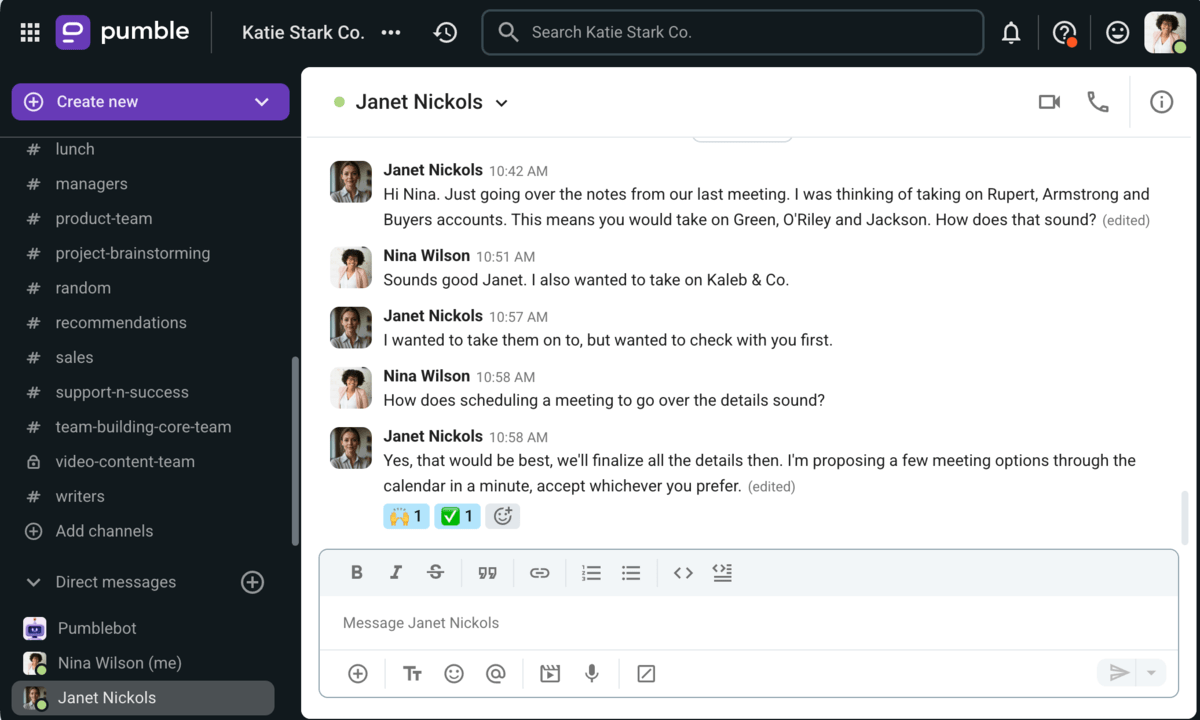
Simplifier la communication directe avec Pumble
Conseils pour améliorer les négociations entre les employés
Parvenir à un accord dans les négociations entre employés peut être un chemin semé d'embûches et mener à un conflit si ce n'est pas exécuté avec soin. Voici quelques conseils pour vous aider dans ce genre de situations :
- Découvrez la motivation de l'autre partie. Peu importe ce que vous essayez de négocier, en apprendre davantage sur les motivations de l'autre personne peut vous aider à comprendre pourquoi elle veut ce qu'elle veut et comment vous pourriez trouver une solution qui fonctionne pour les deux.
- Restez calme. Il est vital que vous gardiez vos émotions à distance. Cela vous permettra non seulement de garder la tête froide, mais cela vous aidera également à maintenir les négociations professionnelles et à ne pas entrer en conflit avec votre collègue.
- Soyez respectueux, mais tenez bon. Reconnaissez les besoins de l'autre personne, mais respectez aussi les vôtres et travaillez à trouver une solution créative qui vous conviendrait à tous les deux.
Négociations d'employé à employeur
Les négociations employé-employeur impliquent des discussions entre les employés et leurs employeurs, comme un employé et le PDG de leur entreprise, qui cherchent à parvenir à un accord mutuellement bénéfique.
Exemple : Le représentant d'une entreprise de marketing négocie avec un consultant en design indépendant le prix de ses services de conseil récurrents.
Conseils pour améliorer les négociations avec votre employeur
Les négociations avec votre employeur peuvent être effrayantes, car vous devez être très prudent de ne rien dire qui pourrait vous faire tomber en disgrâce. Voici comment le faire avec respect :
- Maintenez un ton professionnel. Même si vous vous sentez lésé par l'entreprise et pensez mériter mieux, vous devez garder votre sang-froid et montrer que vous êtes un professionnel capable de négocier un changement avec grâce.
- Aidez à comprendre pourquoi vous méritez ce que vous demandez. Préparez-vous bien à l'avance, réfléchissez à vos forces et essayez de les persuader avec des faits. Évitez tout type de manipulation émotionnelle, car cela pourrait nuire à votre réputation et ruiner vos chances de réussir.
- Évitez les ultimatums. Faire un ultimatum (« Donnez-moi ce que je veux, ou bien... »), peu importe la politesse avec laquelle vous le formulez, est l'opposé des négociations. En fait, vous privez votre employeur d'une chance de négocier et lui laissez un choix binaire.
Conseils pour améliorer les négociations avec vos employés
Peu importe ce que vous essayez de négocier avec un employé, même si votre décision est la dernière, vous devez respecter le point de vue de l'employé. Voici comment négocier n'importe quoi avec un employé :
- Écoutez attentivement. En tant qu'employeur, vous avez la responsabilité de prendre soin de vos employés et de leur offrir des conditions de travail appropriées. Donnez-leur la chance de s'expliquer et d'expliquer ce qu'ils veulent, et écoutez attentivement.
- Soyez honnête. Si vous devez leur dire une vérité désagréable, soyez honnête et ne tournez pas autour du pot. Si vous ne pouvez pas leur accorder une augmentation de salaire en raison d'une situation financière défavorable pour le moment, dites-le tout de suite et essayez de trouver une autre solution.
- Prenez votre temps. Si vous avez besoin d'un moment pour traiter leurs demandes et voir si elles sont réalisables, il est préférable de prendre votre temps et de revenir vers eux sur la question plutôt que de prendre une décision hâtive.
Négociations d'employé à tiers
Les négociations d'employé à tiers impliquent des discussions entre les représentants d'une entreprise et des tiers, tels qu'un employé et un client potentiel, dans le but de parvenir à un accord mutuellement bénéfique.
Exemple : Un responsable des opérations négociant un contrat de services avec un vendeur réservé pour la nourriture de la fête de Noël dans l'entreprise.
Conseils pour améliorer les négociations d'employé à tiers
Les négociations internes sont plus faciles que celles avec des parties externes car chacun est conscient du fonctionnement interne de l'organisation et de ce qu'il peut attendre, ce qui ne peut être dit des parties externes. Voici comment naviguer dans les négociations avec des tiers :
- Compartimentalisez. Montrez une volonté de coopération et une certaine souplesse. Il est préférable de négocier section par section pour trouver la meilleure solution, sur mesure.
- Fixez une date limite pour la décision finale. Si vous laissez les négociations durer trop longtemps sans trouver de terrain d'entente à la fin, vous risquez de manquer d'autres excellentes opportunités entre-temps.
- Priorisez. Lors de la négociation d'accords complexes, il est probable que les deux parties devront faire des concessions. Cependant, il est utile de pouvoir clarifier vos priorités dès le départ et de demander la même chose à l'autre partie.
Négociations distributives
Les négociations distributives impliquent des discussions entre deux parties concernant une seule question, comme le prix d'un service ou d'un produit.
Exemple : Un spécialiste des ventes discutant de la possibilité de prolonger l'utilisation gratuite des services d'un produit pour une entreprise cliente, au-delà de la période d'essai gratuite habituelle d'un mois.
Conseils pour améliorer les négociations distributives
Selon un article de la Harvard Law School sur la négociation distributive, il existe des stratégies de communication utiles pour conclure une excellente affaire dans ce type de négociation :
- Définissez votre BATNA. La « Meilleure alternative à un accord négocié », ou BATNA, (« Best alternative to a negotiated agreement ») est votre plan B si vous n'atteignez pas votre objectif actuel (par exemple, embaucher un autre entrepreneur si le prix actuel est trop élevé).
- Définissez votre point de réservation. C'est la limite que vous atteindrez avant de vous tourner vers votre BATNA (par exemple, vous ne paierez pas un entrepreneur plus de 1 000 $, et s'il ne baisse pas le prix, vous vous tournerez vers votre plan B).
- Découvrez le point de réservation et le BATNA de l'autre partie. Cette étape vous aidera à comprendre si un accord est possible.
- Déterminez s'il existe une ZOPA. La ZOPA (« Zone of possible agreement ») ou « Zone d'accord possible » est l'espace entre vos points de réservation et ceux de l'autre partie. Par exemple, si vous ne paierez pas plus de 1 000 $ et que l'entrepreneur n'acceptera rien de moins de 900 $, votre ZOPA se situe entre ces deux chiffres.
Négociations intégratives
Les négociations intégratives impliquent des discussions entre deux parties concernant plusieurs questions. Si les parties impliquées sont intéressées à gagner différents arguments sur différentes questions, un compromis qui apporte aux deux parties ce qu'elles veulent est possible, voire probable.
Exemple : Une experte financière, à qui l'on vient de proposer un poste de planification financière, négociant avec la responsable des RH d'une banque son salaire, ses avantages sociaux et sa date de début. Les négociations se concluent par l'experte financière obtenant plus d'avantages que ceux initialement offerts, pour compenser un salaire légèrement inférieur à celui qu'elle avait initialement demandé, et avec les deux parties se mettant facilement d'accord sur la date de début.
Conseils pour améliorer les négociations intégratives
Les négociations intégratives ne sont pas aussi gagnant-perdant que les négociations distributives, donc, d'une certaine manière, elles sont plus faciles à gérer. Voici comment gérer ce type de négociations avec succès :
- Décomposez-le. Ce type de négociation exige de décomposer l'accord en parties plus petites et de négocier chacune séparément. De cette façon, vous pouvez tous les deux « gagner » des parties de la négociation.
- Trouvez des intérêts communs. Soyez ouvert et encouragez l'autre partie à s'ouvrir sur ses intérêts. De cette façon, vous pourriez découvrir une solution surprise qui vous conviendrait parfaitement à tous les deux.
- Pensez à long terme. Peut-être que l'accord n'est pas idéal pour vous maintenant, mais il serait bénéfique d'établir une relation avec l'autre partie pour le bénéfice à long terme de l'entreprise. Dans ce cas, soyez orienté vers l'avenir.
Négociations d'équipe
Les négociations d'équipe impliquent des discussions entre des groupes de personnes, qui ensemble forment deux équipes ou plus.
De telles équipes sont généralement transversales et se composent de professionnels qui possèdent des connaissances, une expérience, des talents et des compétences différents qui sont pertinents pour aider l'équipe à obtenir ce qu'elle veut pendant les négociations.
Le processus de négociation entre équipes comprend généralement les éléments suivants :
- Des rôles spécifiques pour des membres spécifiques des équipes,
- Des stratégies de négociation claires,
- Des pauses fréquentes pour discuter des progrès et résoudre les éventuels désaccords entre les membres d'une équipe.
Exemple : Les représentants légaux de deux entreprises de marketing qui se concentrent sur les produits discutant des termes d'une éventuelle fusion entre les deux entreprises.
Conseils pour améliorer les négociations d'équipe
Les négociations d'équipe peuvent devenir quelque peu alambiquées puisque tout le monde dans toutes les équipes participantes doit être sur la même longueur d'onde. Voici quelques conseils pour vous aider à vous préparer aux négociations d'équipe :
- Négociations intra-équipe. Avant de vous asseoir à la table de négociation avec l'autre équipe ou les autres équipes, vous devez décider de votre position en tant qu'unité unique. Si un membre de l'équipe propose les conditions de l'équipe pour être ensuite contredit par un autre membre de l'équipe, les autres parties n'hésiteront pas à exploiter cette discrépance et à la faire fonctionner pour elles.
- Attribuez des rôles. Chaque membre de l'équipe devrait avoir son propre rôle dans le processus de négociation, et ces rôles devraient être clairs pour tout le monde avant que vous ne commenciez à négocier.
- Préparez une stratégie et tenez-vous-en. Avant de commencer le processus de négociation, établissez une stratégie que vous utiliserez, assurez-vous que tous les collègues la comprennent, et tenez-vous-en.
Améliorer la communication inter-équipes avec Pumble
Négociation multipartite
La négociation multipartite implique des discussions entre 3 parties ou plus — les parties impliquées dans les négociations multipartites peuvent faire partie d'une équipe ou avoir leurs propres agendas distincts.
Ces négociations ont le potentiel de devenir trop complexes pour être facilement gérées, mais la multitude de parties et les problèmes discutés aident à créer plus de valeur dans la discussion.
Exemple : Une équipe de 6 personnes a une session de brainstorming qui génère 3 opinions distinctes sur le nom possible d'un nouveau produit.
La session de brainstorming se transforme rapidement en une négociation entre 3 sous-équipes de deux, chacune soutenant et ayant des arguments valables pour l'un des noms proposés. La sous-équipe dont le nom est choisi gagnera de la reconnaissance dans l'entreprise, surtout si le produit s'avère être un succès.
Enfin, une grande valeur est atteinte, car un nom est choisi pour le produit, et les deux autres sont mis de côté, pour être pris en considération lors de futures sessions de brainstorming pour les noms de produits.
Conseils pour améliorer les négociations multipartites
Les négociations multipartites sont encore plus complexes que les négociations d'équipe car il peut être difficile de parvenir à un accord qui bénéficierait à tous. Voici quelques conseils sur la façon de mieux les gérer :
- Envisagez de rejoindre une coalition. S'il y a trop de parties impliquées, vous aurez plus de chances de faire entendre votre voix si vous rejoignez une coalition de groupes ayant des intérêts similaires.
- Désignez un facilitateur. Il est parfois judicieux de faire appel à une personne sans enjeux dans la négociation pour arbitrer le processus et établir une sorte d'ordre.
- Calculez vos chances. Écoutez attentivement ce que les autres visent, calculez vos chances et ajustez vos objectifs en conséquence.
Négociations ponctuelles
Les négociations ponctuelles impliquent des discussions entre des parties qui se rencontrent une fois pour des négociations et ne sont pas censées négocier ensemble à l'avenir.
De telles négociations peuvent impliquer plusieurs réunions mais ne devraient pas se répéter de quelque manière que ce soit après qu'un accord a été conclu.
Exemple : Le manager des opérations d'une entreprise à la recherche de nouveaux bureaux pour le nombre croissant d'employés de l'entreprise. Une fois que le prix d'un espace approprié a été négocié avec succès et que l'espace a été acheté, la personne qui a vendu l'espace n'est pas censée s'engager davantage avec les représentants de l'entreprise.
Conseils pour de meilleures négociations ponctuelles
Ce type de négociation est le plus risqué car c'est une affaire unique où les parties impliquées n'espèrent pas une relation durable. Voici comment mener des négociations ponctuelles :
- Faites une vérification des antécédents. Avant même de vous asseoir à table avec l'autre partie, assurez-vous qu'il s'agit d'une entreprise ou d'une personne réputée qui ne vous jouera pas de tours.
- Ne cédez pas rapidement. Restez ferme dans votre décision jusqu'à ce que vous ayez compris l'étendue de la volonté de compromis de l'autre partie.
- Préservez votre réputation. Ce type de négociation peut être un accord ponctuel, mais vous voulez toujours être respectueux de l'autre partie et faire preuve de votre intégrité et de votre fiabilité. Chaque action que vous entreprenez affecte votre réputation globale.
Négociations répétées
Les négociations répétées impliquent des discussions entre des parties qui devraient se rencontrer et négocier de manière répétée. Ces parties sont plus susceptibles de travailler plus dur à créer une confiance mutuelle et une atmosphère agréable et plus coopérative lors des négociations, car elles s'attendent à communiquer à nouveau à l'avenir.
Exemple : Une entreprise qui produit en masse une pléthore de nouveaux produits chaque trimestre, ce qui oblige l'équipe marketing à se réunir fréquemment, à brainstormer des idées et à négocier les meilleures options pour les noms des nouveaux produits.
Conseils pour améliorer négociations répétées
Dans les négociations répétées, les deux parties sont beaucoup plus susceptibles de jouer franc jeu, car le contraire pourrait entraîner la résiliation du partenariat ou un autre type d'arrangement entre elles. Voici quelques conseils pour des négociations répétées réussies :
- Établissez un modèle. Les négociateurs qui se rencontrent régulièrement pourraient bénéficier d'une approche structurée de la négociation. Savoir comment fonctionne le processus de négociation peut aider chacun à venir préparé et à parvenir à un accord plus rapidement.
- Soyez attentif à l'autre partie. Faites un effort considérable pour toujours trouver la solution qui convient aux deux parties.
- Pensez à votre intérêt commun avant la négociation. Prenez en compte les intérêts de l'autre partie ainsi que les vôtres avant de commencer à négocier afin de pouvoir les rencontrer à mi-chemin au début et faire gagner du temps à tout le monde.
Conflicts
Selon le dictionnaire Merriam-Webster, un conflit est une « action compétitive ou opposée d'incompatibles ». Il est généralement le résultat d'idées, d'intérêts, de personnalités, de styles de communication, d'expériences et d'autres différences opposées entre collègues.

Les conflits peuvent aussi impliquer les 5 types de communication, à des degrés divers — mais les conflits verbaux sont parmi les types les plus courants, car les conflits ont tendance à se produire en face à face.
De plus, un manque d'écoute active et de compréhension est souvent une raison pour laquelle les conflits surviennent. Selon une étude intitulée Les conflits en milieu de travail et comment les entreprises peuvent les exploiter pour prospérer, un employé typique aux États-Unis seulement passe 2,1 heures par semaine impliqué dans divers types de conflits.
Le même rapport démontre en outre à quel point les conflits sont répandus, considérant que pas moins de :
- 85 % des employés y sont confrontés à un certain niveau, et
- 29 % des employés y sont confrontés presque tout le temps.
Les conflits sur le lieu de travail proviennent généralement de :
- L'interdépendance dans le travail,
- Les différences de styles de travail,
- Les différences de styles de leadership,
- Les parcours professionnels ou personnels et
- Les personnalités différentes.
Voici ce que chaque type de conflit en milieu professionnel représente.
Conflits d'interdépendance
Les conflits d'interdépendance surviennent lorsqu'une personne a besoin de s'appuyer sur un collègue pour sa coopération ou son apport, afin de pouvoir continuer ou terminer son travail — et le travail et l'aide de collègues ne sont pas à la hauteur en termes de ponctualité et de qualité.
Exemple : Un directeur des ventes est en retard avec les chiffres de ventes mensuels, ce qui le met en conflit avec le comptable de l'entreprise, car ce problème se répète sur une base mensuelle, et ralentit significativement l'avancement du travail du comptable.
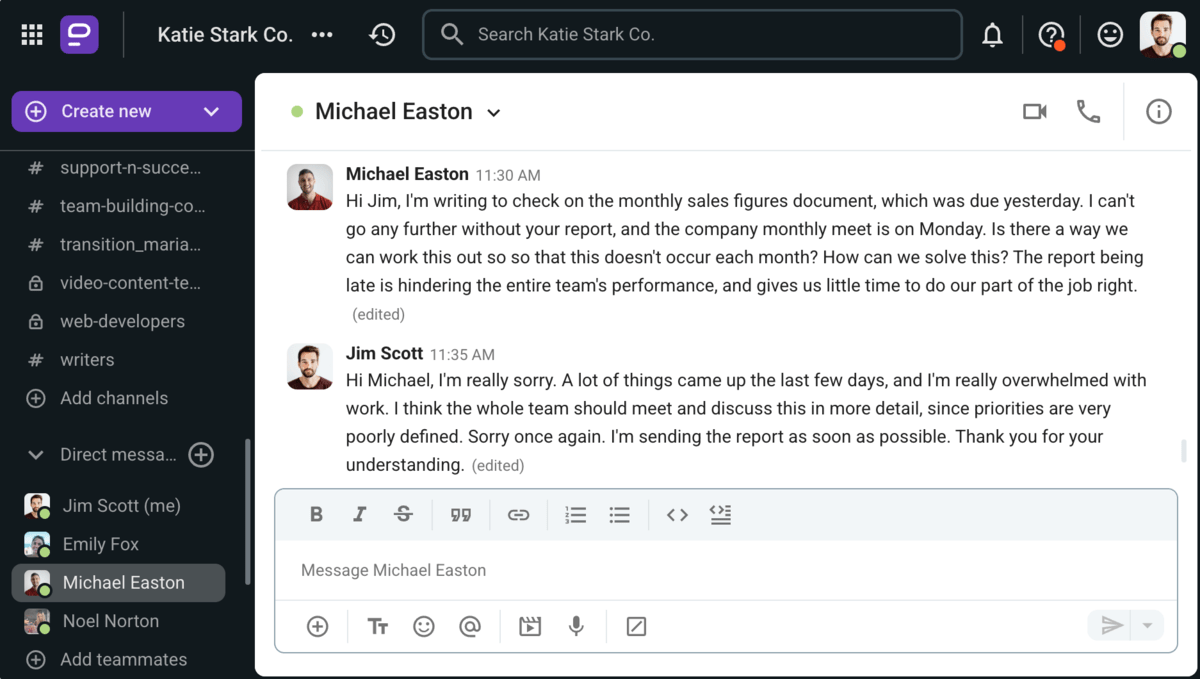
Comment résoudre un conflit d'interdépendance
Il est difficile de faire votre travail quand un collègue dont vous dépendez ne fait pas sa part, c'est pourquoi vous devez trouver un moyen de résoudre le conflit avec lui dès que possible, en utilisant ces conseils :
- Parlez à votre collègue ouvertement et calmement. Un ton neutre et l'ouverture pourraient suffire à résoudre le conflit, car les collègues sont moins susceptibles de se mettre sur la défensive si vous ne les attaquez pas et montrez une volonté d'écouter.
- Essayez de trouver une solution ensemble. Leur version de l'histoire pourrait révéler la raison de leurs actions, et vous pouvez trouver une solution ensemble.
- Demandez une délégation des tâches. Si l'effort ci-dessus ne fonctionne pas, parlez à un supérieur ou aux RH, expliquez la situation et demandez-leur de vous attribuer un autre collègue.
Résoudre les conflits rapidement et facilement avec Pumble
Conflits liés à des différences de styles de travail
Les conflits qui surviennent en raison de différences de styles de travail se produisent lorsque des personnes qui travaillent ensemble ont des préférences différentes quant à la façon dont elles aiment travailler et ont des désaccords concernant ces styles de travail.
Exemple : Une moitié d'une équipe de vente est axée sur les tâches et préfère tout faire rapidement. L'autre moitié de l'équipe de vente est axée sur les personnes et préfère discuter des problèmes et des solutions avec tout le monde, longuement. Cela conduit à des conflits occasionnels qui nécessitent une communication supplémentaire pour être résolus.
Comment résoudre un conflit lié à des différences de styles de travail
Se fier à des styles de travail différents pour faire avancer les choses n'a pas à entraver une bonne communication. Voici comment résoudre un conflit découlant de différences de styles de travail :
- Respectez les différences. Essayez d'accepter que tout le monde ne pense pas et ne fait pas les choses de la même manière que vous, afin que cela n'affecte pas votre travail ou ne vous frustre pas.
- Faites que les différences fonctionnent pour vous. Au lieu de trouver ces différences agaçantes, vous pourriez être en mesure de les utiliser à votre avantage mutuel — déléguez ou confiez à chaque personne la tâche dans laquelle elle excellerait probablement et qu'elle apprécierait.
Conflits liés à des différences de contexte
Les conflits qui surgissent en raison des différences de contexte des personnes sont liés à des différences de :
- Expériences professionnelles et de vie,
- Connaissances,
- Éducation,
- Âge,
- Genre,
- Culture,
- Ethnicité, ou même
- Préférences politiques.
De telles différences dans les parcours des personnes n'engendrent des conflits que lorsque les gens y prêtent une attention inutile et font des suppositions sur les opinions, les compétences et les talents des personnes basées sur celles-ci.
Exemple : Un responsable marketing senior rejette immédiatement l'idée d'un membre junior du service marketing lors d'une réunion de brainstorming, en raison de son jeune âge et de son inexpérience supposée, ce qui entraîne une légère dispute entre plusieurs participants à la réunion.
Comment résoudre un conflit liée à des différences de contexte
Les conflits qui se produisent en raison des différences de contexte entre collègues peuvent souvent être discriminatoires et, par conséquent, entraîner de graves conséquences (même juridiques). Pour résoudre ce type de conflit, essayez de :
- Vérifier vos préjugés. La personne a-t-elle fait quelque chose pour vous agacer, ou avez-vous des préjugés envers un certain groupe de personnes auquel elle appartient ?
- Alerter les RH. Si vous êtes de l'autre côté de ce type de conflit et que vous vous sentez discriminé, vous voudrez peut-être impliquer les RH qui sauront désamorcer la situation et prendre toutes les mesures supplémentaires pour l'éviter à l'avenir.
Conflits liés à des différences de styles de leadership
Les conflits qui surgissent en raison de différences de styles de leadership se produisent lorsque les employés doivent suivre les instructions de plusieurs leaders différents qui ont des styles différents, ce qui peut entraîner confusion et frustration.
Exemple : Le directeur du support client a un style de leadership plus décontracté de type laissez-faire avec l'équipe de support client, tandis que le directeur de la technologie (en anglais, « Chief Technology Officer; CTO ») qui communique fréquemment avec les membres de l'équipe de support a un style de leadership plus contrôlant et autocratique.
En conséquence, les membres de l'équipe de support entrent en conflit pour savoir s'ils demandent trop de conseils et de directions supplémentaires (du point de vue du directeur du support client), ou s'ils ne suivent pas suffisamment les conseils et directions supplémentaires (du point de vue du CTO).
Comment résoudre un conflit lié à des différences de styles de leadership
En tant que supérieurs qui doivent s'assurer que leurs équipes fonctionnent au niveau optimal, vous devez vous accorder sur la manière de les diriger, quelles que soient vos différences de styles de leadership. Voici comment gérer les conflits découlant de ces différences :
- Assumez la responsabilité. Si un conflit est survenu en raison de différences de leadership, en tant que supérieurs, admettez que l'erreur était la vôtre et mettez-vous d'accord sur la marche à suivre dans la situation. Cela désamorcera le conflit, car la responsabilité sera levée des épaules des employés.
- Établissez un ensemble de principes de leadership et respectez-les. Quelles que soient vos différences, vous devez vous accorder et vous aligner sur les valeurs et principes généraux de l'entreprise. De cette façon, vous pouvez suivre ces principes chaque fois que vous ne savez pas ce que vous devez faire dans une situation donnée.
- Convenez et standardisez les procédures. Si vous standardisez certaines procédures, vos différences de styles de leadership ne causeront pas de problèmes, car tous les supérieurs communiqueront avec les employés de la même manière prescrite.
Conflits liés à des différences de personnalité
Les conflits qui surgissent en raison de différences de personnalité se produisent à cause de dispositions différentes entre les collègues, en termes de la manière dont ils se comportent, dont ils pensent et réagissent, de ce qu'ils aiment ou n'aiment pas.
Exemple : Un responsable hiérarchique a une dispute avec un employé qui arrive souvent en retard au bureau. Du point de vue du responsable hiérarchique, l'employé est « paresseux » et « irresponsable ». Du point de vue de l'employé, le responsable hiérarchique le réprimande constamment parce qu'il ne l'aime pas.
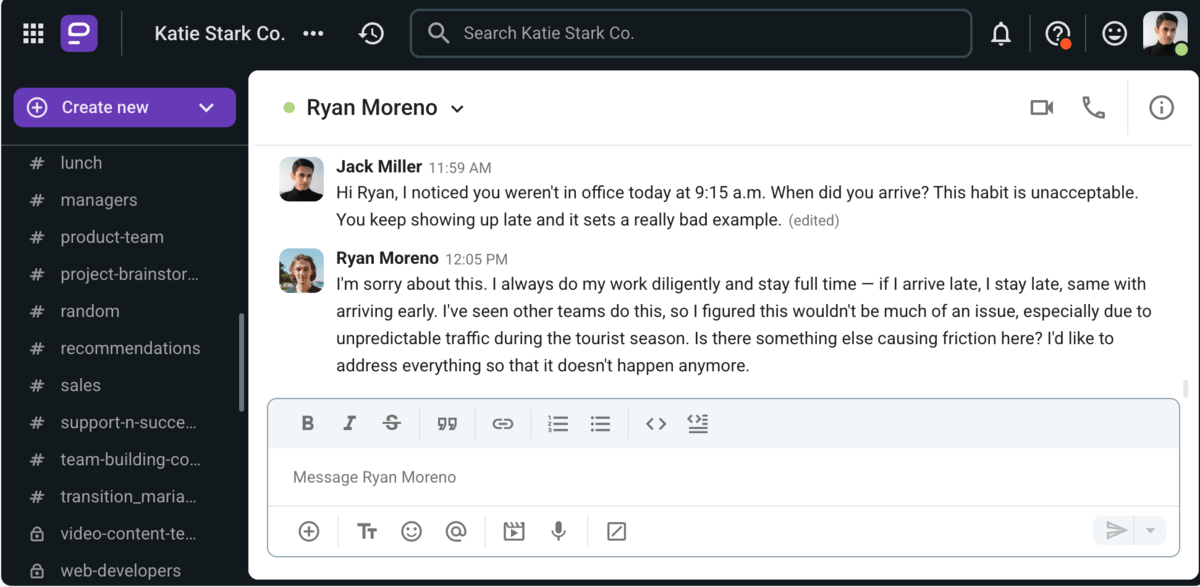
Résoudre clairement les conflits sur Pumble
Comment résoudre un conflit lié à des différences de personnalité
Comme nous sommes tous différents, des chocs de personnalité sont inévitables. Cependant, apprendre à bien communiquer peut vous aider à résoudre ces conflits plus facilement. Voici quelques conseils pour gérer les désaccords liés aux personnalités :
- Adoptez le point de vue de l'autre personne. Il est beaucoup plus facile de se comprendre mutuellement si l'on prend en compte le point de vue de l'autre.
- Soyez honnête. Exprimer honnêtement ce qui vous dérange, sans vous laisser emporter par vos émotions, est un excellent point de départ pour résoudre un conflit. Cela vous permet aussi de déterminer si le comportement de l'autre vous affecte réellement de manière négative, ou si vous êtes simplement agacé parce que les choses ne sont pas faites à votre manière.
- Négociez un compromis. Chacun est unique, et toute relation, qu'elle soit personnelle ou professionnelle, nécessite un effort constant pour trouver des compromis afin de fonctionner.
🎓 Astuce Pro de Pumble
Pour en savoir plus sur la manière de régler ou d'éviter les conflits sur le lieu de travail, consultez notre blog :
Entretiens d'embauche
Selon la définition, un entretien d'embauche comprend une ou plusieurs conversations entre un candidat à un poste et un représentant de l'employeur (généralement, le ou les membres de l'équipe des RH). C'est un test de sélection mené pour évaluer si un candidat est un choix approprié pour le poste en termes de compétences, de personnalité et de compétences sociales.

Ces entretiens peuvent être structurés ou non, selon les personnes qui les mènent.
La communication écrite marque généralement le début du processus de recrutement : le ou la spécialiste RH contacte par email les candidats dont le CV semble pertinent. Cet email peut contenir les détails d'un exercice à réaliser et/ou proposer une date et une heure pour un entretien en personne.
Par la suite, la communication verbale devient prédominante. Cependant, le ou la spécialiste RH peut en apprendre beaucoup plus sur les candidats en analysant leurs expressions faciales, leur posture et leurs gestes lorsqu'ils répondent aux questions.
Selon l'offre d'emploi et s'il est lié à un domaine créatif, les exercices donnés au cours du processus peuvent inclure des éléments visuels, comme des designs à retravailler.
Les candidats et les représentants de l'entreprise doivent également s'écouter activement. Les candidats doivent le faire pour bien comprendre les questions et y répondre au mieux de leurs capacités. Les représentants de l'entreprise, quant à eux, doivent le faire pour comprendre et analyser les réponses, afin de déterminer si les candidats sont adaptés au poste.
En ce qui concerne les types d'entretiens d'embauche, on distingue :
- Les entretiens téléphoniques,
- Les entretiens en face à face,
- Les entretiens de groupe,
- Les entretiens pendant les repas,
- Les entretiens par visioconférence,
- Les entretiens comportementaux,
- Les entretiens de stress,
- Les entretiens de départ.
Voici ce que chaque type d'entretien d'embauche implique.
Entretiens d'embauche par téléphone
Les entretiens d'embauche par téléphone sont une étape préliminaire courante dans le processus de recrutement. Ils sont utilisés lorsque cette première prise de contact ne se fait pas par email et servent à évaluer rapidement si le candidat correspond au profil recherché avant de passer à des entretiens plus approfondis.
Au cours de cet échange, le spécialiste des ressources humaines contacte le candidat pour vérifier ses compétences, son expérience et ses qualifications en lien avec le poste à pourvoir.
Le recruteur peut également poser des questions pour déterminer si le candidat s'intégrerait bien à la culture de l'entreprise. C'est souvent à ce moment que le recruteur et le candidat s'accordent sur la date, l'heure et le lieu d'une rencontre en personne.
Exemple : Un spécialiste RH mène un rapide entretien téléphonique avec un candidat dont le CV et la lettre de motivation se distinguent et le désignent comme un postulant prometteur pour le poste vacant de chef de produit.
Besoin d'une alternative aux emails ? Essayez Pumble
Conseils pour les entretiens d'embauche par téléphone
La particularité d'un entretien d'embauche par téléphone est que le recruteur ne peut pas vous voir. La communication non verbale est donc exclue, et vous devez vous fier presque exclusivement à votre voix. Voici comment réussir un entretien téléphonique :
- Articulez vos mots. Parlez clairement et assurez-vous que chaque mot soit compréhensible.
- Adoptez un ton à la fois professionnel et chaleureux. Vous voulez paraître à la fois intelligent et sympathique. Sourire peut vous aider. Bien que le recruteur ne puisse pas vous voir, on peut souvent entendre un sourire dans la voix de quelqu'un.
- Écoutez attentivement. Sans indices visuels, vous devez concentrer toute votre attention sur l'écoute attentive de votre interlocuteur pour ne rien manquer.
Entretien d'embauche en personne
L'entretien d'embauche en personne est le format le plus courant, et il a généralement lieu après un premier échange téléphonique.
Au cours de cet entretien, le spécialiste des ressources humaines pose au candidat des questions plus détaillées sur ses compétences, son expérience et sa formation. Il pose aussi des questions pour mieux cerner la personnalité du candidat, et déterminer s'il s'intégrerait bien à la culture de l'entreprise.
Les candidats qui ont su le mieux mettre en valeur leurs compétences et leur expertise peuvent s'attendre à plusieurs rondes d'entretiens en personne avant de recevoir une offre d'emploi.
À un moment donné du processus, ou pendant toute sa durée, le spécialiste des ressources humaines peut être rejoint par le futur supérieur direct de la personne qui occupera le poste.
Dans les entreprises qui emploient des développeurs et d'autres professionnels techniques, il est également de coutume d'organiser un entretien technique. Celui-ci inclut des défis et des missions que le candidat peut s'attendre à effectuer s'il est embauché.
Exemple : Un candidat au poste de professeur de littérature anglaise passe une série d'entretiens en personne avec un spécialiste des ressources humaines et le vice-doyen de l'école.
Conseils pour les entretiens d'embauche en personne
Toutes les règles de la courtoisie téléphonique s'appliquent également aux entretiens en personne : parlez clairement de manière professionnelle et écoutez attentivement. Voici quelques conseils supplémentaires pour les entretiens en face à face :
- Utilisez le langage non verbal à votre avantage. Souriez pour montrer votre amabilité, maintenez un contact visuel pour indiquer votre confiance et votre détermination, évitez de gigoter et montrez clairement que vous êtes à l'aise.
- Préparez-vous à l'avance, mais soyez honnête. Réfléchissez aux questions qui pourraient vous être posées et à la meilleure façon d'y répondre. Cependant, ne donnez pas de réponses factices que vous pensez plaire au recruteur, car cela se verra probablement.
- Donnez des exemples concrets. Si le recruteur vous demande comment vous résoudriez un problème hypothétique, utilisez si possible un exemple de la façon dont vous avez déjà géré une situation similaire avec succès. Les exemples concrets ont beaucoup plus de valeur que les réponses génériques évidentes.
🎓 Astuce Pro de Pumble
Pour d'autres conseils pratiques sur la manière de réussir un entretien en personne, consultez notre article de blog :
Entretiens de groupe
Les entretiens de groupe sont des entretiens d'embauche qui opposent deux ou plusieurs candidats postulant pour le même poste. Le ou la spécialiste des RH et le reste de l'équipe d'entretien leur posent des questions pertinentes.
Ce type d'entretien vise à évaluer le professionnalisme des candidats, leurs compétences en matière de leadership et leur capacité à communiquer et à travailler en groupe.
Exemple : La dernière étape pour le poste de spécialiste des ventes inclut un entretien commun avec deux candidats différents. Un seul obtiendra l'offre, mais le futur spécialiste des ventes devra travailler au sein d'une équipe des ventes, donc sa capacité à communiquer avec les autres est une condition préalable essentielle.
Conseils pour les entretiens de groupe
Un entretien de groupe est autant un test de vos compétences en communication qu'une évaluation de vos aptitudes et de votre expérience. La clé pour réussir ce type d'entretien est d'être attentif et de savoir s'adapter. Voici quelques conseils pour vous démarquer :
- Respectez les autres candidats. Écouter attentivement, montrer votre soutien en hochant la tête et ne pas interrompre les autres démontrera vos compétences en communication et votre professionnalisme.
- Utilisez les réponses des autres et enrichissez-les. Écoutez attentivement votre interlocuteur et réfléchissez à la manière dont vous pouvez utiliser sa réponse et y ajouter de la valeur, ce qui montrera votre sens de l'écoute.
- Adoptez une approche conversationnelle. Pensez à l'entretien comme à une conversation plutôt qu'à une compétition. Détendez-vous et intégrez-vous naturellement à la discussion au lieu d'essayer de vous démarquer à tout prix.
Entretiens d'embauche pendant les repas
Les entretiens d'embauche pendant le petit-déjeuner ou déjeuner sont organisés lorsque le responsable du recrutement ou un spécialiste des ressources humaines souhaite observer le comportement du candidat dans un cadre plus informel.
Exemple : Un responsable du recrutement déjeune avec un candidat pour un poste d'assistant de rédaction dans un journal.
Conseils pour les entretiens pendant les repas
Les entretiens pendant un repas sont plus décontractés que les entretiens traditionnels. Cependant, ils sont souvent plus longs et vous devez penser à bien plus que vos réponses aux questions habituelles. Voici comment les réussir :
- Habillez-vous pour un entretien. Respectez le code vestimentaire de votre employeur potentiel, quel que soit le lieu de rendez-vous.
- Faites attention à ce que vous commandez. Vos préférences alimentaires ne regardent pas votre interlocuteur, mais la commande est une question de praticité. Si vous commandez quelque chose de salissant, comme un sandwich géant avec toutes les garnitures possibles, vous aurez du mal à parler tout en mangeant.
- Suivez son exemple. Comme un entretien pendant un repas est un peu plus décontracté, vous n'aurez pas à vous en tenir au répertoire habituel de questions. Vous pouvez aussi poser des questions plus personnelles, mais il est toujours préférable de rester prudent en suivant l'exemple de l'interviewer pour le niveau de décontraction de la conversation.
Entretiens d'embauche par visioconférence
Les entretiens d'embauche par visioconférence (également appelés entretiens à distance) sont des entretiens qui se déroulent via un outil de visioconférence.
Cela se produit généralement soit parce qu'il serait plus compliqué pour le candidat de se déplacer au siège de l'entreprise (par exemple, si le siège est à l'étranger), soit parce que les entretiens par visioconférence sont une pratique courante dans l'entreprise en question.
Exemple : Un candidat pour un poste de chef de produit vit actuellement à l'étranger. L'entretien avec le responsable du recrutement est donc mené par appel vidéo sur l'application de communication d'équipe Pumble.
Conseils pour les entretiens par visioconférence
Les entretiens d'embauche en vidéo peuvent être similaires à ceux en face à face, mais vous devez vous assurer de maîtriser la technologie qui sert d'intermédiaire à votre rencontre. Voici quelques conseils pour faire bonne impression lors d'un entretien par visioconférence :
- Préparez la technologie à l'avance. Assurez-vous que votre équipement fonctionne correctement. Essayez et testez les fonctionnalités avant l'entretien pour éviter les problèmes techniques.
- Éliminez les distractions. Assurez-vous que la pièce dans laquelle vous vous trouvez est calme et que personne ne risque de faire irruption. Demandez à vos colocataires ou aux membres de votre famille de ne pas vous déranger ou de faire du bruit.
- Montrez de l'engagement par votre langage corporel et vos expressions faciales. Lors d'un entretien vidéo, vous pouvez maintenir un contact visuel, sourire et hocher la tête en signe d'approbation pour montrer votre engagement.
🎓 Astuce Pro de Pumble
Pour approfondir les techniques du langage corporel en réunion virtuelle, consultez :
Entretiens d'embauche comportementaux
Les entretiens d'embauche comportementaux peuvent avoir lieu à n'importe quel moment au cours du processus de recrutement. Plutôt que de se concentrer uniquement sur les réponses du candidat, la personne qui mène l'entretien est plus attentive aux modèles de comportement qui se dégagent de ces réponses.
Exemple : Un spécialiste des RH demande à un candidat de parler d'une situation où il a dû faire face à un problème inattendu lors d'un emploi précédent. Le spécialiste des RH analyse ensuite comment le candidat a géré la situation, en se basant sur ses propres mots.
Conseils pour les entretiens comportementaux
Les entretiens comportementaux sont basés sur des exemples et des situations réelles, c'est pourquoi une préparation minutieuse est essentielle pour réussir. Voici quelques conseils pour vous préparer au mieux :
- Lisez attentivement la description du poste. Une lecture approfondie de la description peut révéler beaucoup d'informations sur les qualités que l'entreprise recherche chez un candidat.
- Passez en revue vos expériences passées. Trouvez des exemples concrets dans votre parcours professionnel qui démontrent que vous possédez les qualités recherchées par l'entreprise.
- Entraînez-vous à donner des réponses concises. Anticipez les questions qui pourraient vous être posées et préparez-vous, par exemple : « Parlez-nous d'une situation difficile au travail que vous avez réussi à surmonter » ou « Parlez-nous d'une erreur que vous avez commise. Comment l'avez-vous gérée ? ».
Entretiens d'embauche sous stress
Les entretiens d'embauche sous stress ont pour but de tester la réaction du candidat face à des situations stressantes, inattendues ou sous haute pression.
Pour y parvenir, l'intervieweur peut poser des questions à un rythme rapide, encourageant l'autre personne à réfléchir et à répondre rapidement.
Exemple : Dans le domaine de la santé, un responsable RH demande à un candidat pour un poste de chirurgien une série de questions rapides sur des situations chirurgicales possibles. L'objectif est de voir si le candidat pourrait convenir pour les opérations d'urgence, souvent stressantes, dans la vie réelle.
Conseils pour les entretiens sous stress
Ces entretiens peuvent être intimidants, mais si vous êtes bien préparé et confiant en vos capacités, ils peuvent être un défi stimulant. Voici quelques astuces pour bien les aborder :
- Faites des recherches sur l'entreprise. Préparez-vous minutieusement en vous renseignant sur l'entreprise, sa culture, ses valeurs et ses politiques, afin de pouvoir aligner vos réponses.
- Gardez votre calme. Si le rythme des questions s'accélère, cela ne signifie pas que vous devez donner des réponses à la chaîne. Vous pouvez prendre un moment pour réfléchir et répondre calmement.
- Ne le prenez pas personnellement. Selon la nature de l'entretien, l'interviewer peut se montrer impoli, désagréable ou dur, par exemple en simulant une situation avec un client difficile. N'oubliez pas qu'il ne s'agit pas d'un jugement sur vous, mais d'une simple technique pour évaluer votre réaction au stress.
Entretiens de départ
Alors qu'un entretien d'embauche vise à recruter un nouveau collaborateur, l'entretien de départ a pour but de faire un point avec un employé qui quitte l'entreprise.
Ces entretiens sont généralement menés par un membre de l'équipe des ressources humaines. L'objectif est de mieux comprendre les raisons du départ de l'employé et d'en tirer des enseignements pour l'entreprise. Cela permet d'identifier ce qui peut être amélioré, modifié ou ce qui fonctionne bien et doit être conservé dans le fonctionnement de l'entreprise.
Exemple : Un directeur de banque mène un entretien de départ avec un agent d'assurance qui a décidé de quitter la banque après 5 ans de service.
Conseils pour les entretiens de départ
Vous pourriez penser que cet entretien est sans importance puisque vous partez de toute façon, mais c'est loin d'être le cas. Il est crucial de ne pas rompre les ponts. Voici quelques conseils pour bien gérer un entretien de départ :
- Laissez vos émotions de côté. Même si votre départ vous met en colère, gardez ces sentiments pour vos amis. Restez professionnel aux yeux de l'entreprise et partez en bons termes.
- Soyez honnête. L'entreprise souhaite connaître les vraies raisons de votre départ pour pouvoir résoudre les problèmes et réduire le taux de rotation du personnel.
- Préparez-vous à l'avance. Réfléchissez aux points délicats que vous devez aborder et à la meilleure façon de les communiquer sans paraître impoli ou peu professionnel.
Gérez toutes les situations de communication avec Pumble
Comprendre ce qui est attendu de vous dans diverses situations de communication au travail est essentiel pour un bon travail et la progression de votre équipe.
Pour vous assurer que vos équipes gèrent tous les scénarios de communication de la meilleure façon possible, faites-les utiliser Pumble.
Pumble est une application tout-en-un de communication et de collaboration qui facilite toutes les situations de communication :
- Conversations planifiées — via des messages directs, des discussions de groupe ou des canaux dédiés.
- Sessions de feedback — via des appels vidéo individuels.
- Réunions, présentations et négociations — grâce à la fonction de visioconférence.
- Résolution de conflits — grâce à des fonctionnalités telles que les fils de discussion qui simplifient la communication ou les appels vocaux.
- Entretiens d'embauche — grâce à l'accès pour les tiers et aux visioconférences.
Pumble peut transformer la façon dont votre organisation gère la communication — Essayez Pumble de CAKE.com dès aujourd'hui !
Créez votre compte Pumble aujourd'hui

